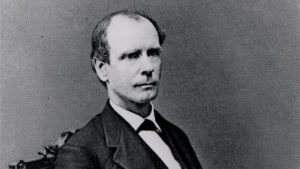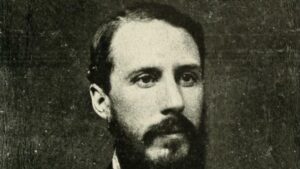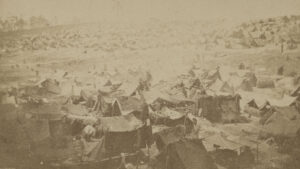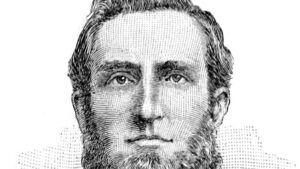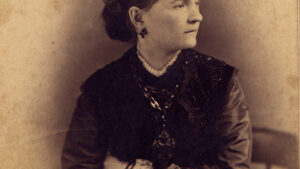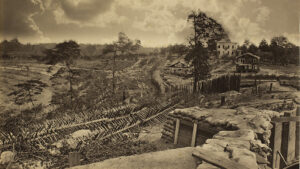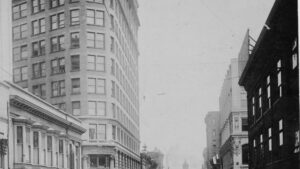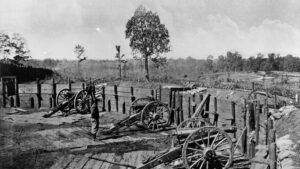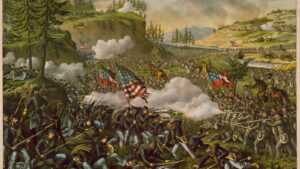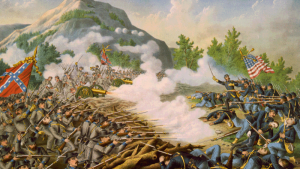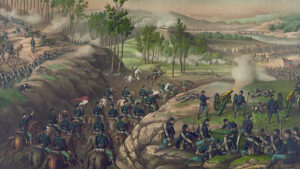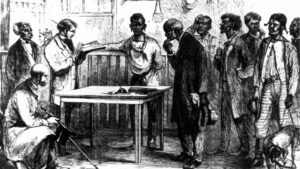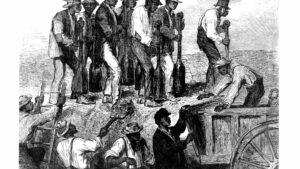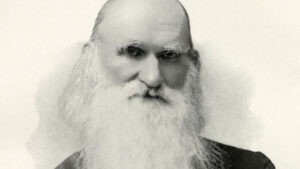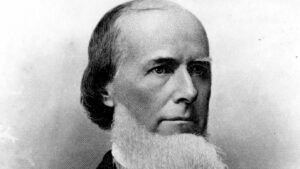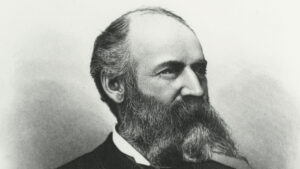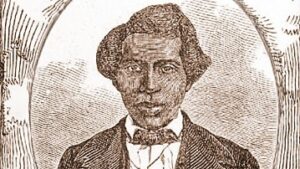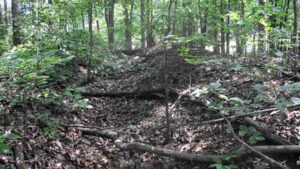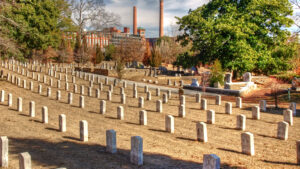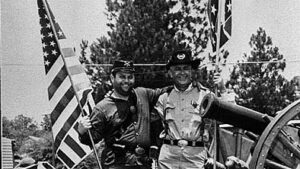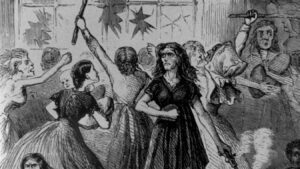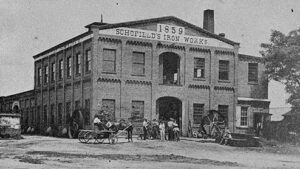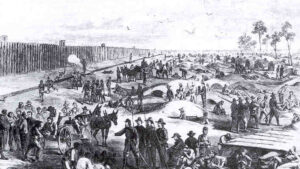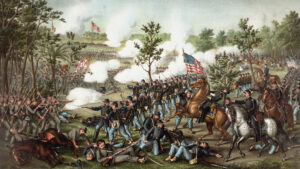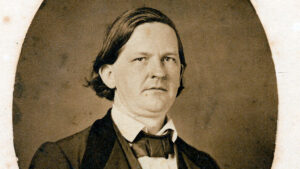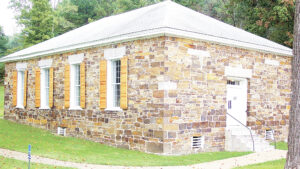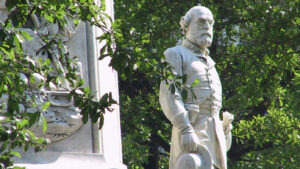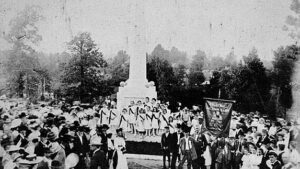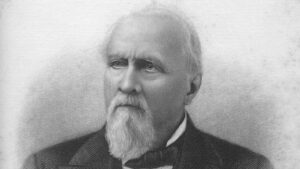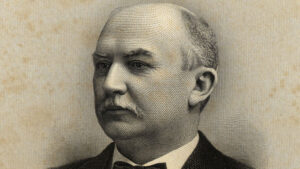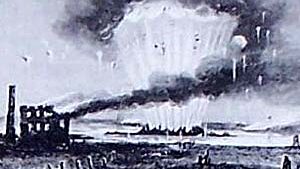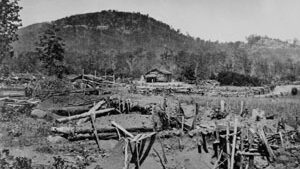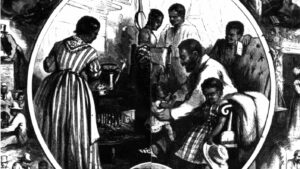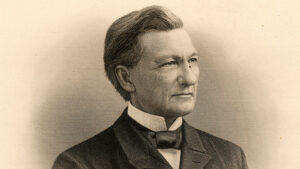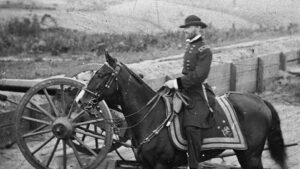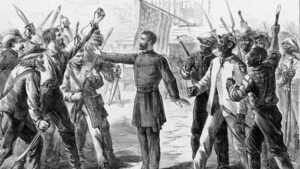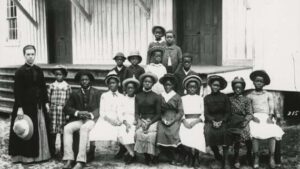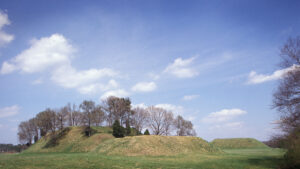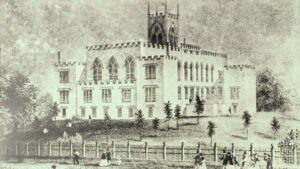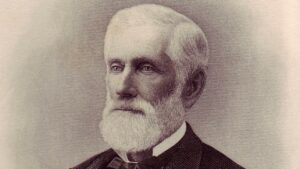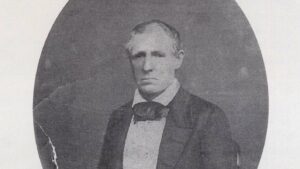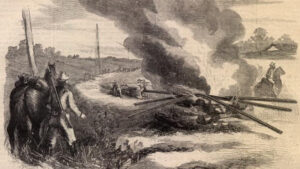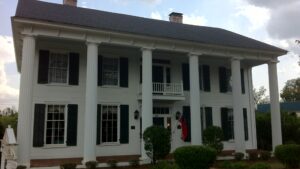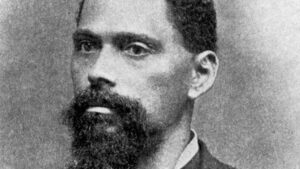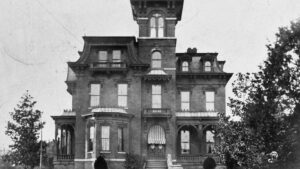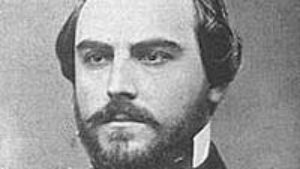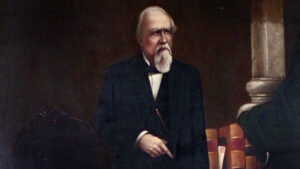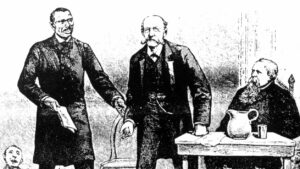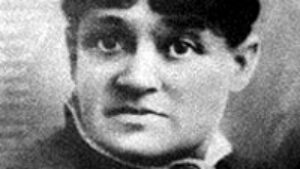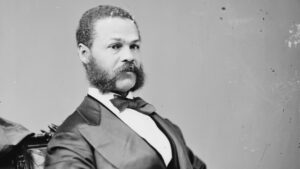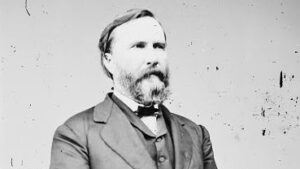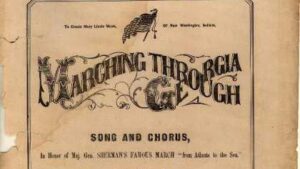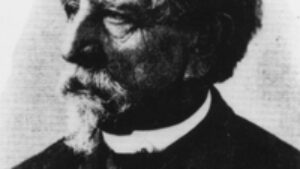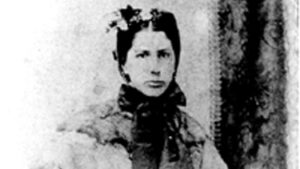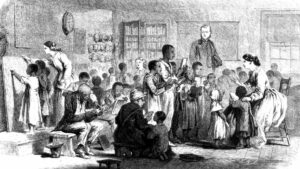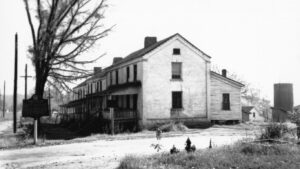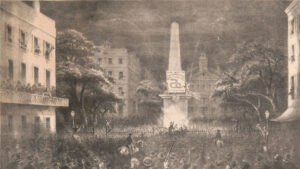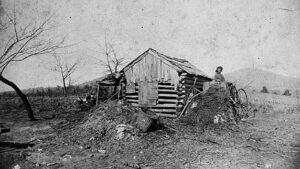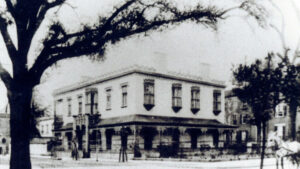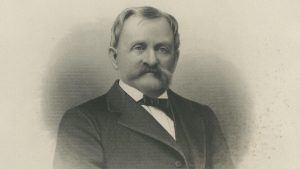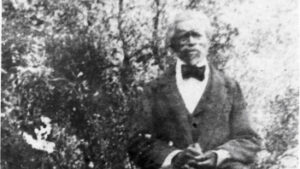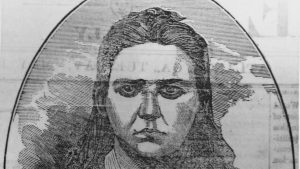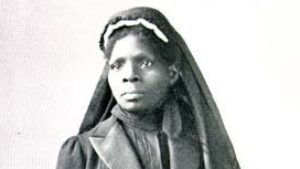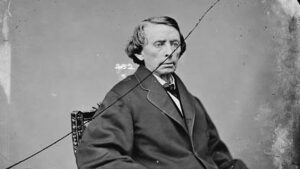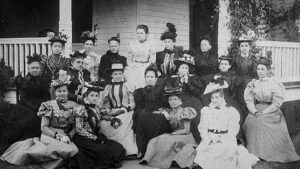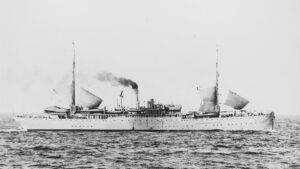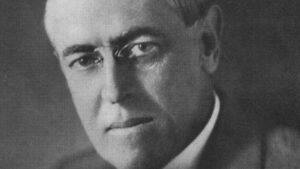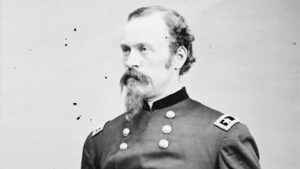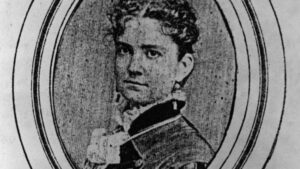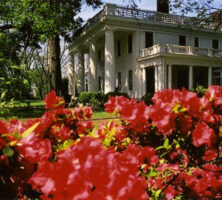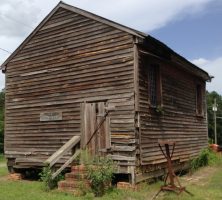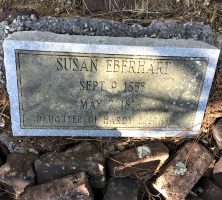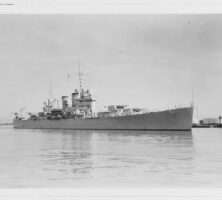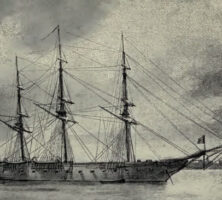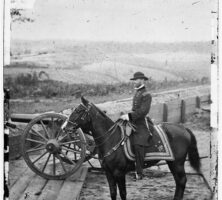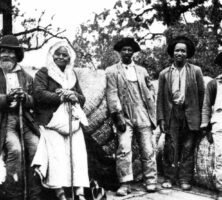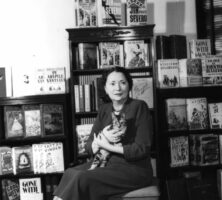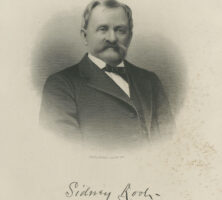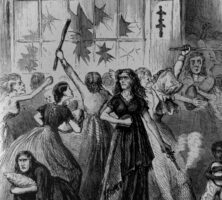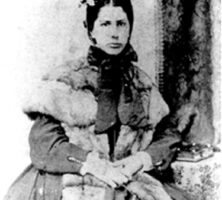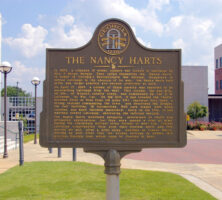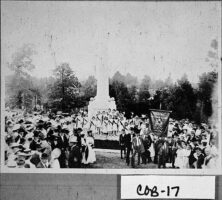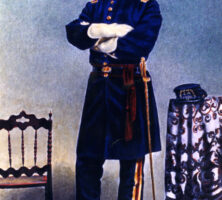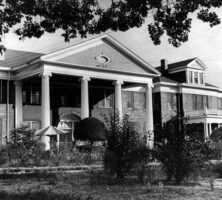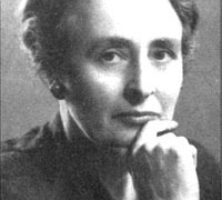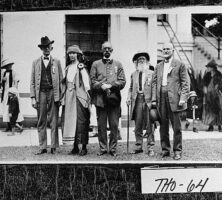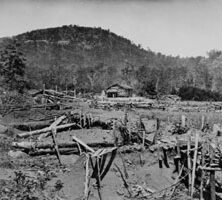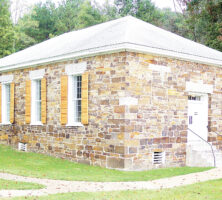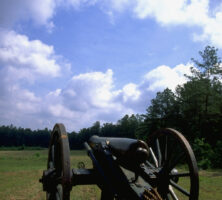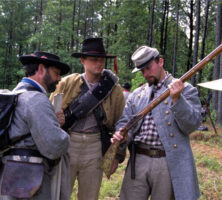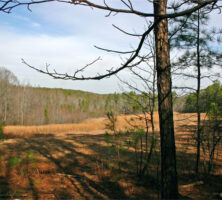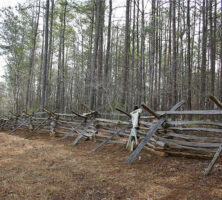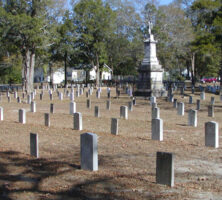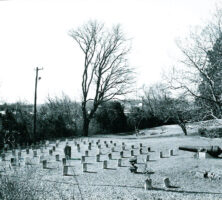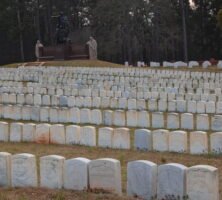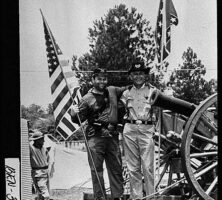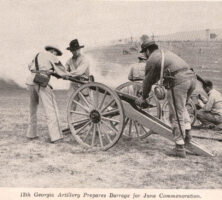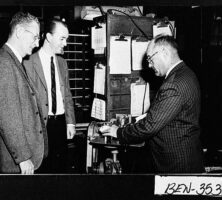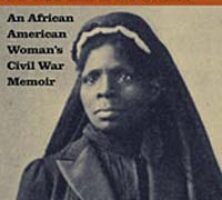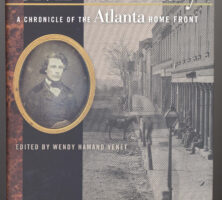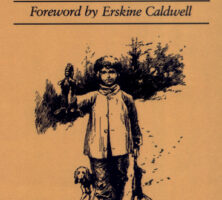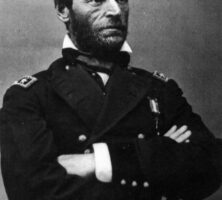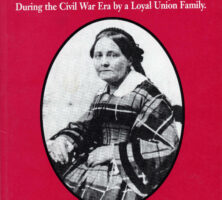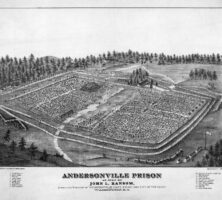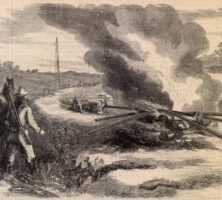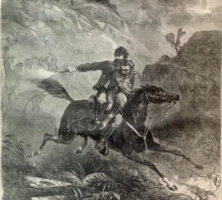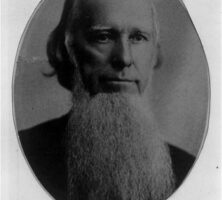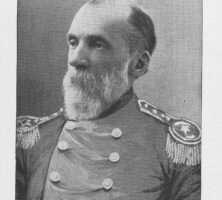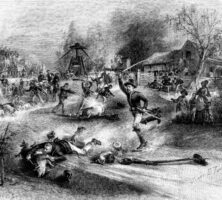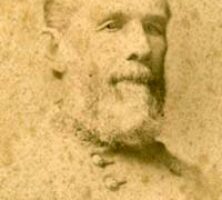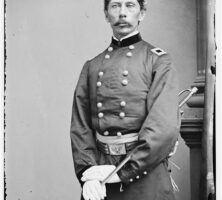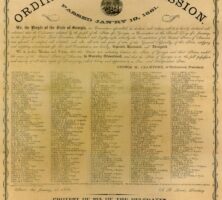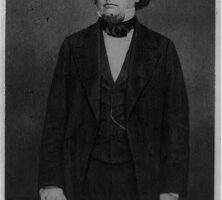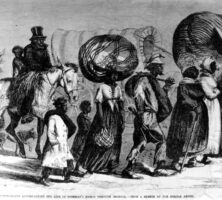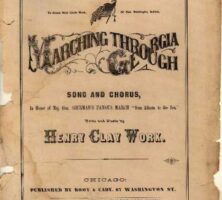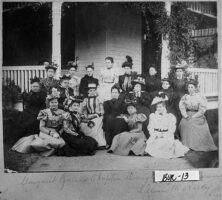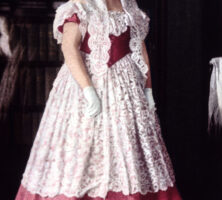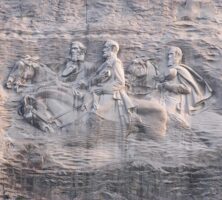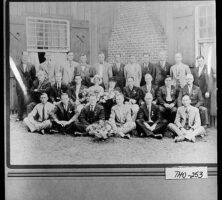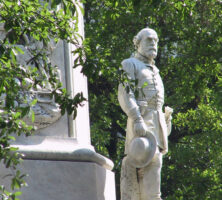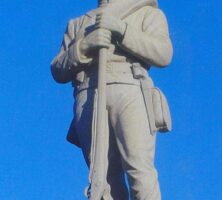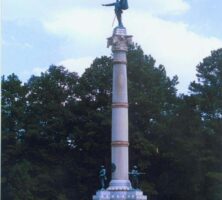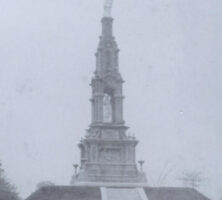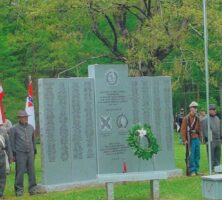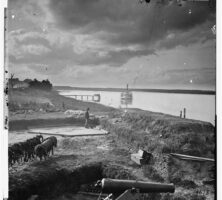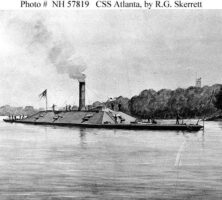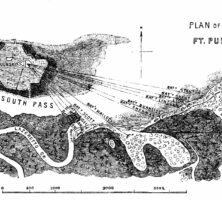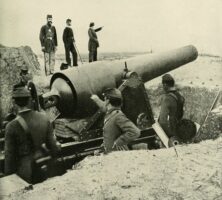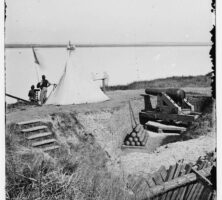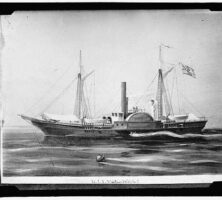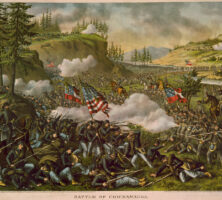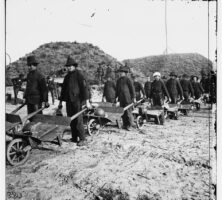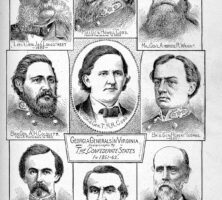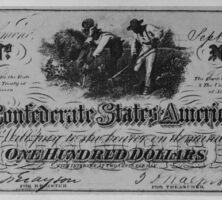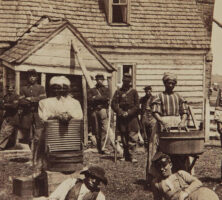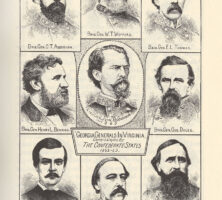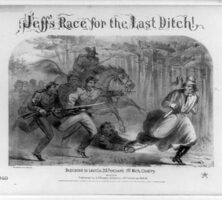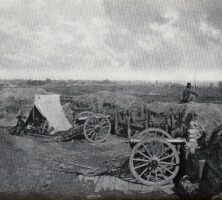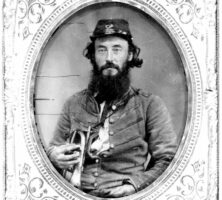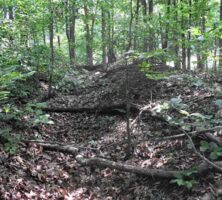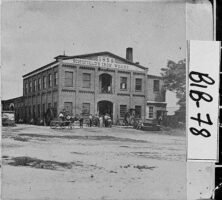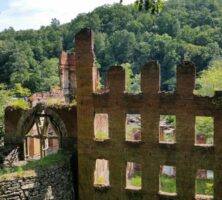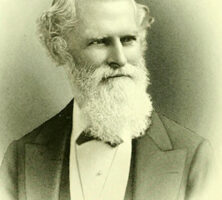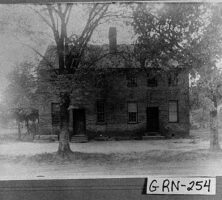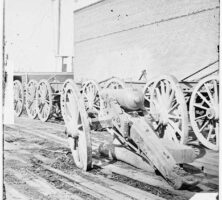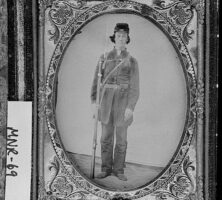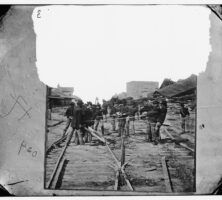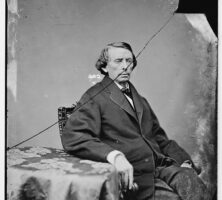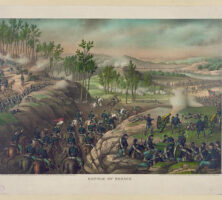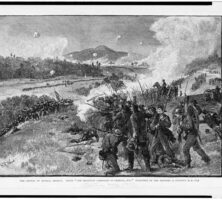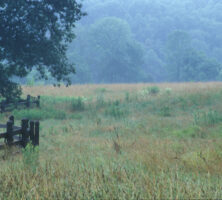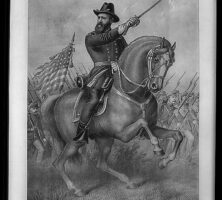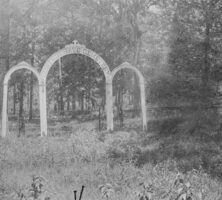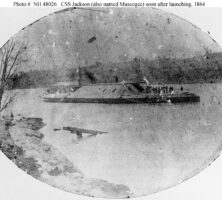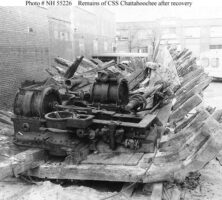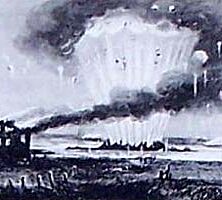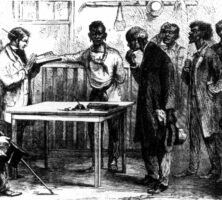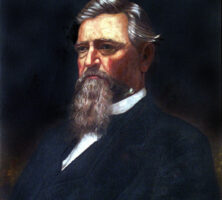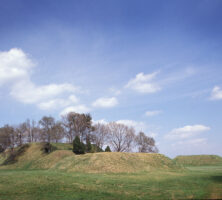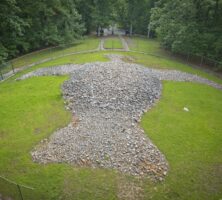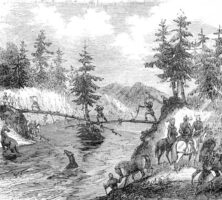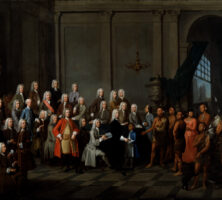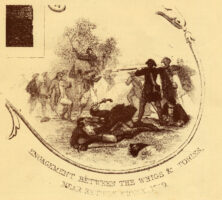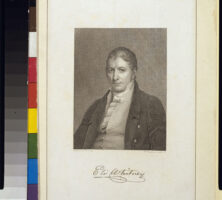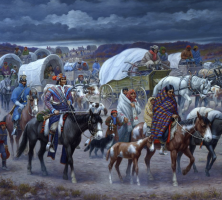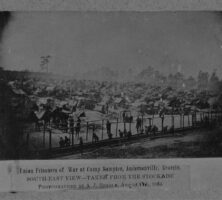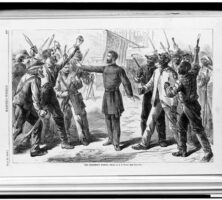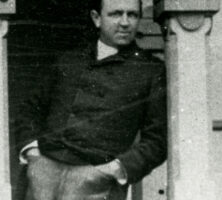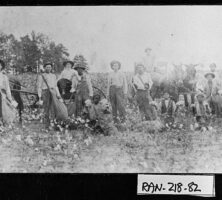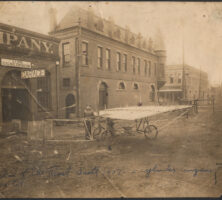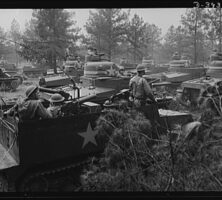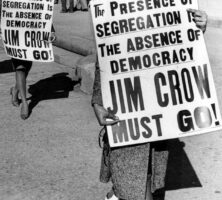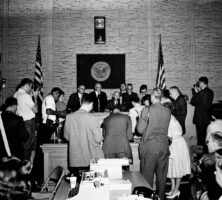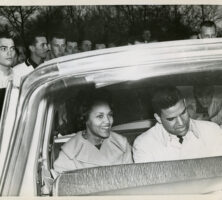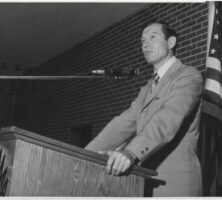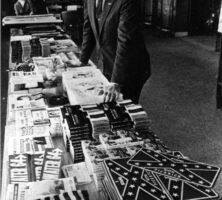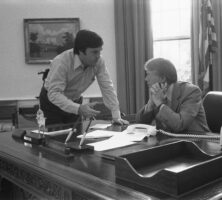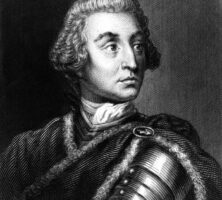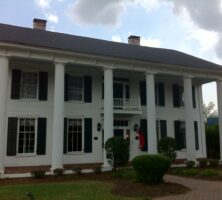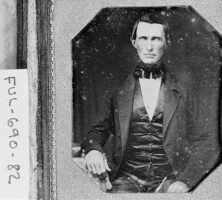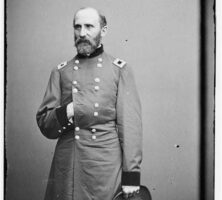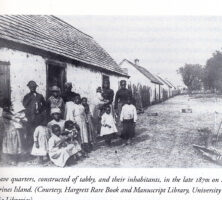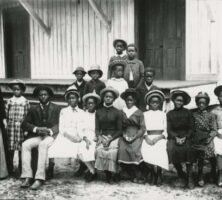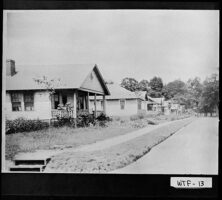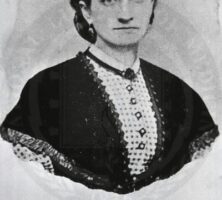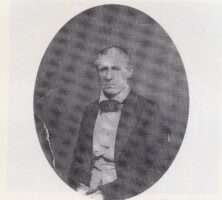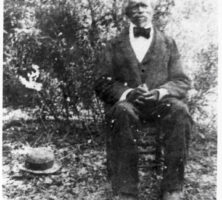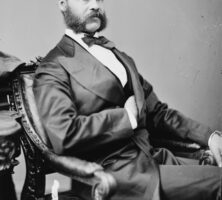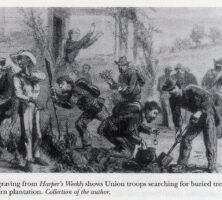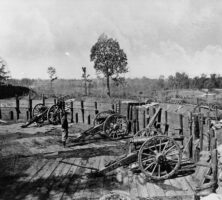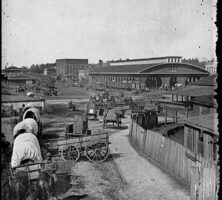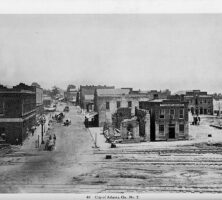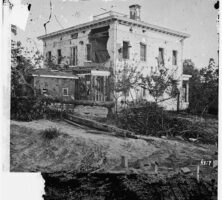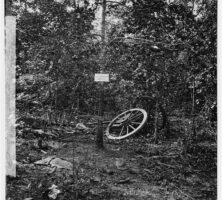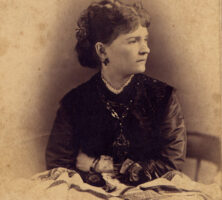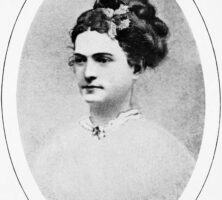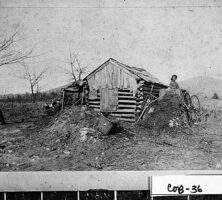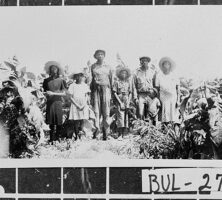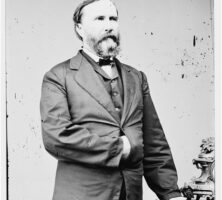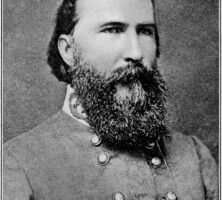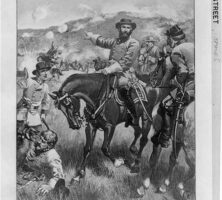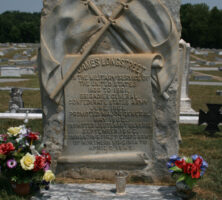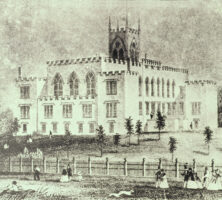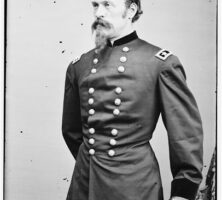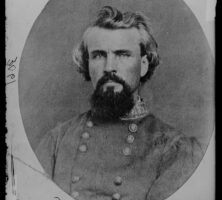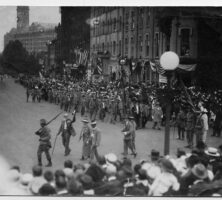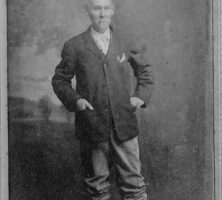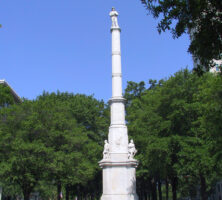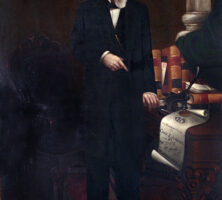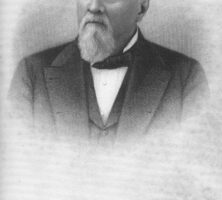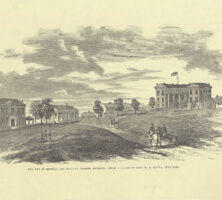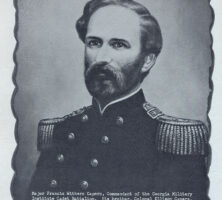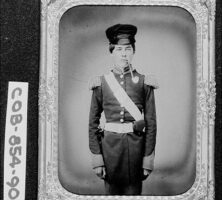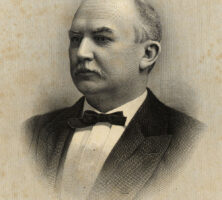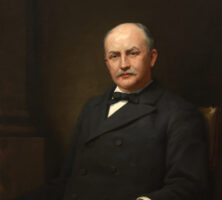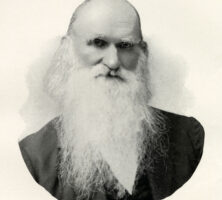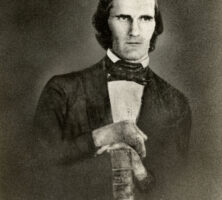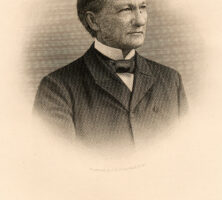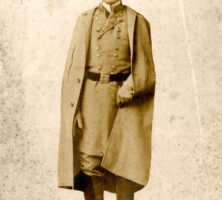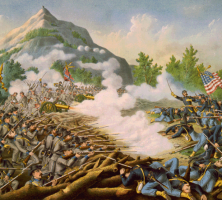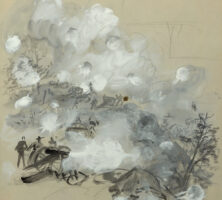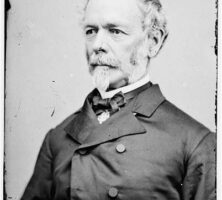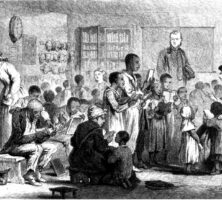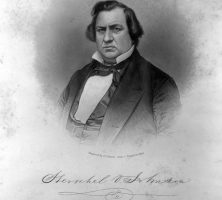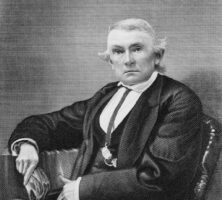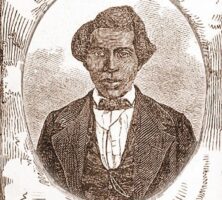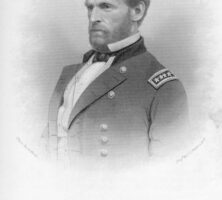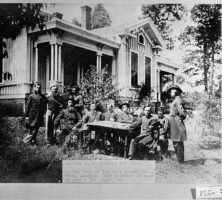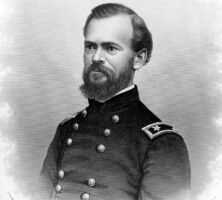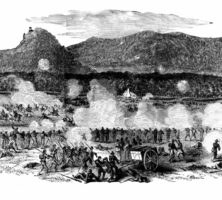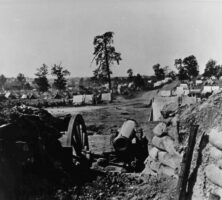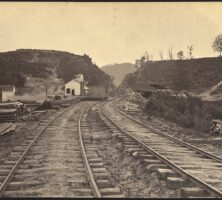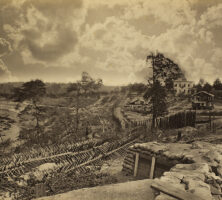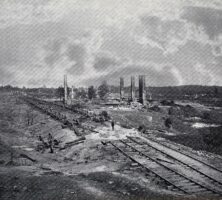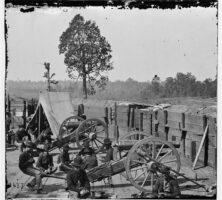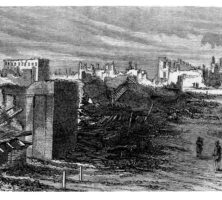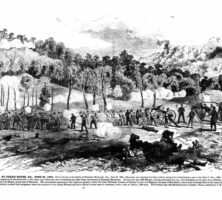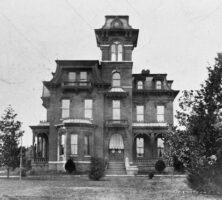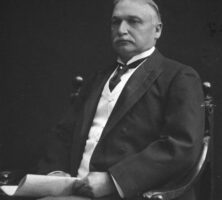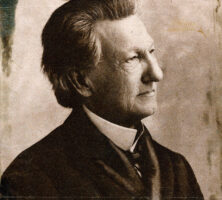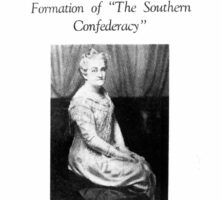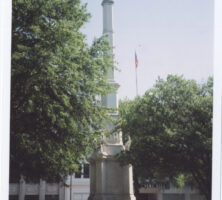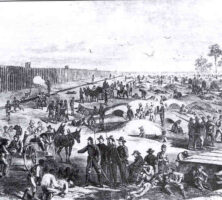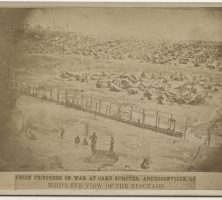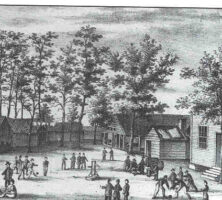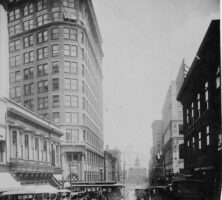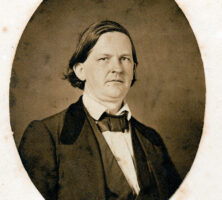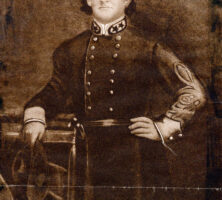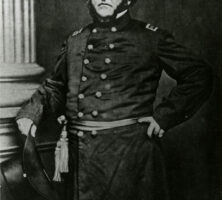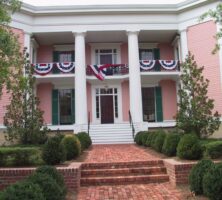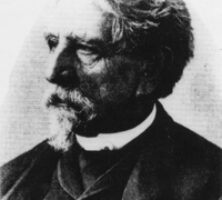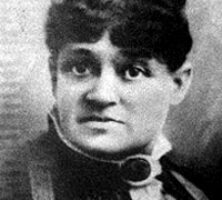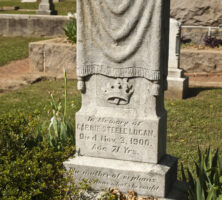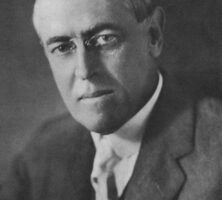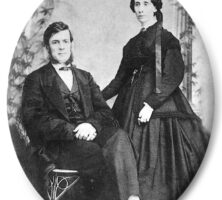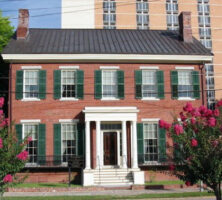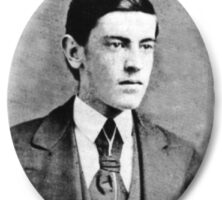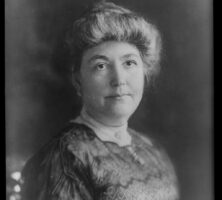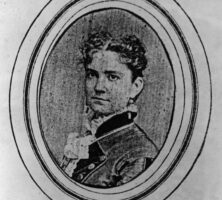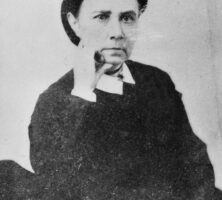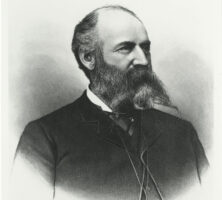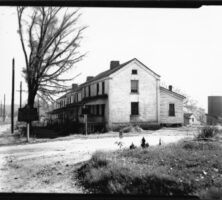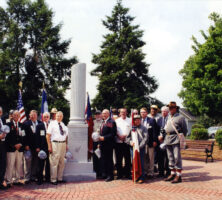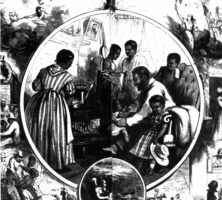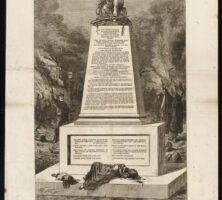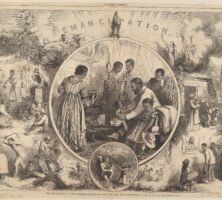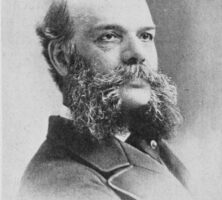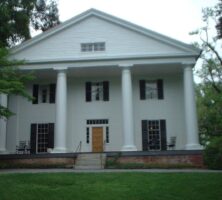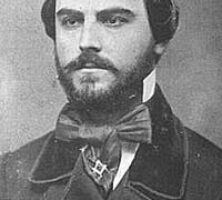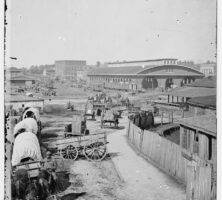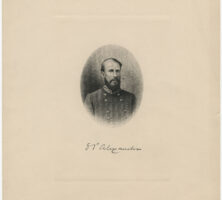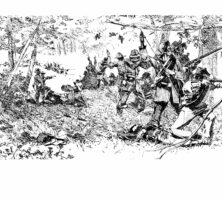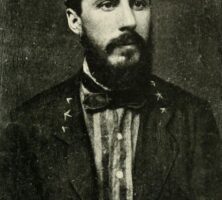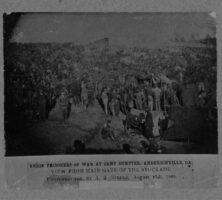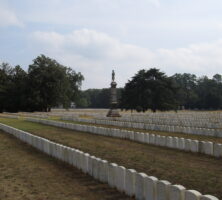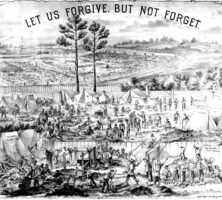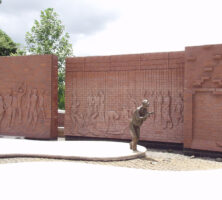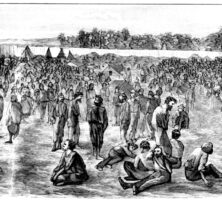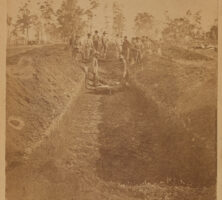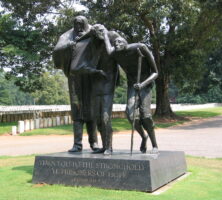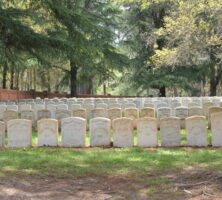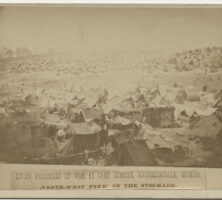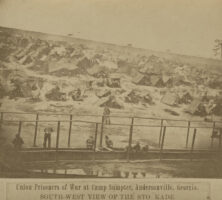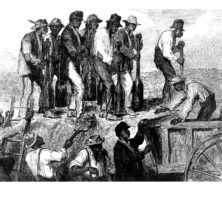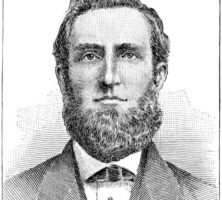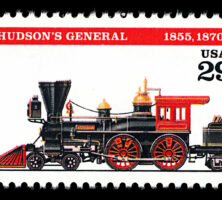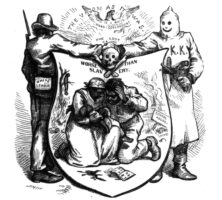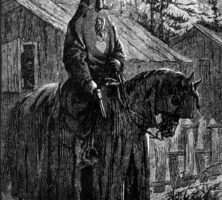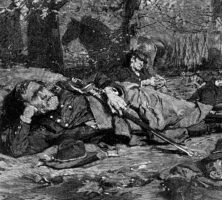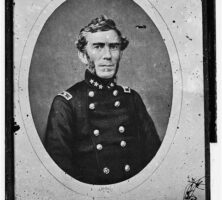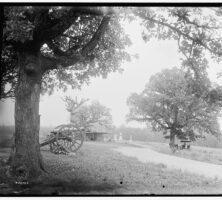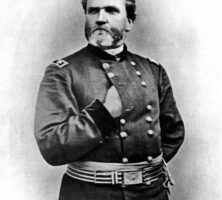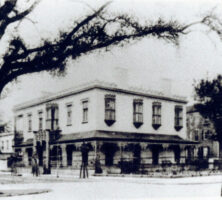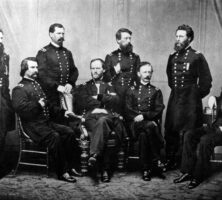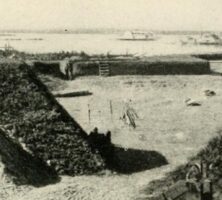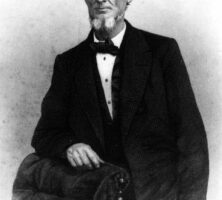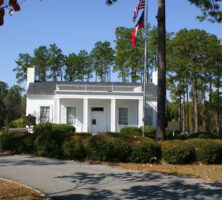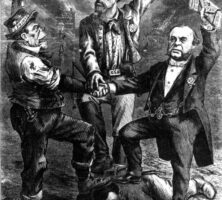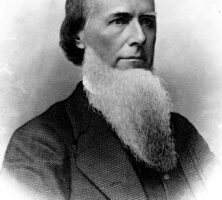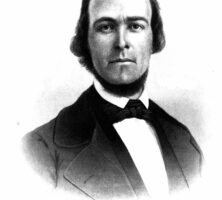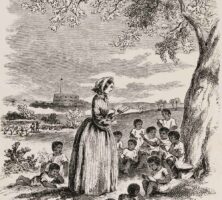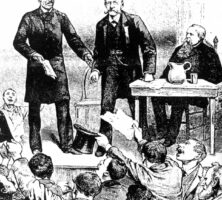The New Georgia Encyclopedia is supported by funding from A More Perfect Union, a special initiative of the National Endowment for the Humanities.
The Joshua Hill House, one of the many antebellum homes in Madison, was built around 1840 for U.S. congressman Joshua Hill, who may have convinced Union general William T. Sherman to spare the town during his March to the Sea. Today it is part of the Madison Historic District.
Courtesy of Georgia Department of Economic Development.
The New Georgia Encyclopedia does not hold the copyright for this media resource and can neither grant nor deny permission to republish or reproduce the image online or in print. Requests for permission to publish or reproduce the resource may need to be submitted to the Georgia Department of Economic Development.
Prior to her execution, Susan Eberhart was held in the old Webster County jail, shown here in 2019. Built in 1856, the jail is among the oldest wooden jails in Georgia.
Courtesy of Fay S. Burnett
The New Georgia Encyclopedia does not hold the copyright for this media resource and can neither grant nor deny permission to republish or reproduce the image online or in print. All requests for permission to publish or reproduce the resource must be submitted to the rights holder.
In 1873 twenty-year-old Susan Eberhart was convicted of murder and sentenced to death by hanging in Preston. Eberhart's highly publicized execution had a significant influence on the administration of capital punishment in Georgia.
From The Atlanta Daily Sun
The New Georgia Encyclopedia does not hold the copyright for this media resource and can neither grant nor deny permission to republish or reproduce the image online or in print. All requests for permission to publish or reproduce the resource must be submitted to the rights holder.
In 1873 Susan Eberhart was executed for the murder of Sarah Spann despite objections from a sympathetic public. Her gravestone, seen here in 2019, sits in Preston Cemetery in Webster County.
Courtesy of Fay S. Burnett
The New Georgia Encyclopedia does not hold the copyright for this media resource and can neither grant nor deny permission to republish or reproduce the image online or in print. All requests for permission to publish or reproduce the resource must be submitted to the rights holder.
The fourth USS Savannah (CL-42) engaged in Atlantic and Meditteranean operations during World War II (1941-45), most notably Operation Torch, the allied invasion of North Africa.
Photograph by Naval History and Heritage Command
The New Georgia Encyclopedia does not hold the copyright for this media resource and can neither grant nor deny permission to republish or reproduce the image online or in print. All requests for permission to publish or reproduce the resource must be submitted to the rights holder.
The second USS Savannah completed naval operations in the Mexican and Civil Wars.
From Old Naval Days: Sketches From the Life of Rear Admiral William Radford, U. S. N. by Sophie Radford De Meissner, Wikimedia
The New Georgia Encyclopedia does not hold the copyright for this media resource and can neither grant nor deny permission to republish or reproduce the image online or in print. All requests for permission to publish or reproduce the resource must be submitted to the rights holder.
The third USS Savannah (AS-8) served as a submarine tender during World War I (1917-18).
Photograph by Naval History and Heritage Command
The New Georgia Encyclopedia does not hold the copyright for this media resource and can neither grant nor deny permission to republish or reproduce the image online or in print. All requests for permission to publish or reproduce the resource must be submitted to the rights holder.
In this photograph, taken by George N. Barnard, Union general William T. Sherman sits astride his horse at Federal Fort No. 7 in Atlanta. Sherman's Atlanta campaign, which lasted through the spring and summer of 1864, resulted in the fall of the city on September 2.
Courtesy of Library of Congress, Prints and Photographs Division, Photograph by George N. Barnard, #LC-DIG-cwpb-03628.
The New Georgia Encyclopedia does not hold the copyright for this media resource and can neither grant nor deny permission to republish or reproduce the image online or in print. All requests for permission to publish or reproduce the resource must be submitted to the rights holder.
Five enslaved people are pictured at Turnwold Plantation, the Eatonton estate of Joseph Addison Turner. Writer Joel Chandler Harris, who lived at Turnwold during the Civil War, drew upon his experiences there to write his Uncle Remus tales, as well as his autobiographical novel On the Plantation.
The New Georgia Encyclopedia does not hold the copyright for this media resource and can neither grant nor deny permission to republish or reproduce the image online or in print. For more information about this resource, contact the Stuart A. Rose Manuscript, Archives, and Rare Book Library at Emory University.
Margaret Mitchell's epic Civil War love story, Gone With the Wind, was published in June 1936. Mitchell was awarded the Pulitzer Prize for the novel in May 1937.
Courtesy of Atlanta Journal-Constitution.
The New Georgia Encyclopedia does not hold the copyright for this media resource and can neither grant nor deny permission to republish or reproduce the image online or in print. All requests for permission to publish or reproduce the resource must be submitted to the Atlanta Journal-Constitution.
Philip Lee Williams, a native of Madison, won the 2004 Michael Shaara Prize for Civil War Fiction for his novel A Distant Flame (2004). The novel chronicles the experiences of protagonist Charlie Merrill before, during, and after the Atlanta campaign of 1864.
The New Georgia Encyclopedia does not hold the copyright for this media resource and can neither grant nor deny permission to republish or reproduce the image online or in print. All requests for permission to publish or reproduce the resource must be submitted to the rights holder.
Sidney Root, a prominent Atlanta businessman, was an integral part of the Confederate war effort during the Civil War. He later served as the director of the International Cotton Exposition of 1881 in Atlanta and, as park commissioner for the city, was instrumental in the building of Grant Park.
The New Georgia Encyclopedia does not hold the copyright for this media resource and can neither grant nor deny permission to republish or reproduce the image online or in print. Requests for permission to publish or reproduce the resource should be submitted to the Hargrett Manuscript and Rare Book Library at the University of Georgia.
The New Georgia Encyclopedia does not hold the copyright for this media resource and can neither grant nor deny permission to republish or reproduce the image online or in print. All requests for permission to publish or reproduce the resource must be submitted to the rights holder.
The New Georgia Encyclopedia does not hold the copyright for this media resource and can neither grant nor deny permission to republish or reproduce the image online or in print. All requests for permission to publish or reproduce the resource must be submitted to the rights holder.
Hunger on the Georgia home front became so serious during the Civil War that food riots, with women as the main participants, broke out all across the state beginning in 1863.
From Frank Leslie's Illustrated Newspaper
The New Georgia Encyclopedia does not hold the copyright for this media resource and can neither grant nor deny permission to republish or reproduce the image online or in print. All requests for permission to publish or reproduce the resource must be submitted to the rights holder.
During the Civil War, Nancy Hill Morgan cofounded the Nancy Harts Militia, a female military unit organized in LaGrange to protect the home front. Morgan, the wife of a Confederate soldier, served as captain of the militia.
Courtesy of Troup County Archives
The New Georgia Encyclopedia does not hold the copyright for this media resource and can neither grant nor deny permission to republish or reproduce the image online or in print. All requests for permission to publish or reproduce the resource must be submitted to the rights holder.
In 1957 the Georgia Historical Commission erected a marker in LaGrange commemorating the Nancy Harts Militia, a female military unit named for Revolutionary War heroine Nancy Hart and organized to guard the city during the Civil War.
Courtesy of Georgia Info, Digital Library of Georgia.
The New Georgia Encyclopedia does not hold the copyright for this media resource and can neither grant nor deny permission to republish or reproduce the image online or in print. Requests for permission to publish or reproduce the resource may need to be submitted to the Digital Library of Georgia.
A conference of the United Confederate Veterans is pictured in Marietta, circa 1900. The UCV was founded in New Orleans, Louisiana, in 1889 to unify the numerous Confederate veteran organizations across the South.
Courtesy of Georgia Archives, Vanishing Georgia, #
cob017.
The New Georgia Encyclopedia does not hold the copyright for this media resource and can neither grant nor deny permission to republish or reproduce the image online or in print. Requests for permission to publish or reproduce the resource should be submitted to the Georgia Archives.
Company D of the 1st Regiment Georgia Volunteer Infantry, known as the Oglethorpe Infantry, are pictured in Augusta in April 1861, at the beginning of the Civil War. This unit was among the first to form a veterans' organization, the Oglethorpe Light Infantry Association in Savannah, at the war's end in 1865.
Courtesy of Georgia Archives, Vanishing Georgia, #
ric051.
The New Georgia Encyclopedia does not hold the copyright for this media resource and can neither grant nor deny permission to republish or reproduce the image online or in print. Requests for permission to publish or reproduce the resource should be submitted to the Georgia Archives.
Charles C. Jones Jr. was the foremost Georgia historian of the nineteenth century. Beginning after the Civil War and continuing into the 1880s, Jones collected Confederate service records and reminiscences of former soliders.
The New Georgia Encyclopedia does not hold the copyright for this media resource and can neither grant nor deny permission to republish or reproduce the image online or in print. Requests for permission to publish or reproduce the resource should be submitted to the Hargrett Manuscript and Rare Book Library at the University of Georgia.
Confederate Soldiers' Home, located at 410 Confederate Avenue in Atlanta, was built in 1902 to house aging Confederate veterans of the Civil War. The Inman family provided a portion of the funds necessary for the home's completion.
Courtesy of Atlanta Journal-Constitution.
The New Georgia Encyclopedia does not hold the copyright for this media resource and can neither grant nor deny permission to republish or reproduce the image online or in print. All requests for permission to publish or reproduce the resource must be submitted to the Atlanta Journal-Constitution.
John B. Gordon rose to prominence during the Civil War, entering as a captain and emerging as a major general. He later served as a U.S. senator and as the governor of Georgia.
Photograph by Wikimedia
The New Georgia Encyclopedia does not hold the copyright for this media resource and can neither grant nor deny permission to republish or reproduce the image online or in print. All requests for permission to publish or reproduce the resource must be submitted to the rights holder.
Lumpkin is best known for her autobiographical novel, The Making of a Southerner (1947), which describes her transition from passive inheritance of white supremacy to conscious rejection of the racial values of a segregated South.
From The Making of a Southerner, by K. D. Lumpkin
The New Georgia Encyclopedia does not hold the copyright for this media resource and can neither grant nor deny permission to republish or reproduce the image online or in print. All requests for permission to publish or reproduce the resource must be submitted to the rights holder.
Attendees of the 1912 national United Confederate Veterans reunion are pictured in Macon, which hosted the event that year. Macon was the only Georgia city besides Atlanta to host the general reunion of the UCV.
Courtesy of Georgia Archives, Vanishing Georgia, #
bib028.
The New Georgia Encyclopedia does not hold the copyright for this media resource and can neither grant nor deny permission to republish or reproduce the image online or in print. Requests for permission to publish or reproduce the resource should be submitted to the Georgia Archives.
Four Confederate veterans attend a reunion in Thomasville in October 1924.
Courtesy of Georgia Archives, Vanishing Georgia, #
tho064.
The New Georgia Encyclopedia does not hold the copyright for this media resource and can neither grant nor deny permission to republish or reproduce the image online or in print. Requests for permission to publish or reproduce the resource should be submitted to the Georgia Archives.
Kennesaw Mountain, pictured after Confederate general Joseph E. Johnston's retreat from the area in July 1864, was the site of an important battle on June 27, 1864. Although Johnston's troops won the battle, they continued to retreat as Union general William T. Sherman advanced toward Atlanta, located about twenty miles to the southeast.
From Photographic Views of Sherman's Campaign, by G. N. Barnard
The New Georgia Encyclopedia does not hold the copyright for this media resource and can neither grant nor deny permission to republish or reproduce the image online or in print. All requests for permission to publish or reproduce the resource must be submitted to the rights holder.
The Old Stone Church in Ringgold was built in 1849 and served as a hospital during the Civil War for troops on both sides of the conflict. The original altar and pews of the church, which today houses a Civil War museum, are still intact.
Courtesy of Catoosa County News
The New Georgia Encyclopedia does not hold the copyright for this media resource and can neither grant nor deny permission to republish or reproduce the image online or in print. All requests for permission to publish or reproduce the resource must be submitted to the rights holder.
The New Georgia Encyclopedia does not hold the copyright for this media resource and can neither grant nor deny permission to republish or reproduce the image online or in print. All requests for permission to publish or reproduce the resource must be submitted to the rights holder.
Macon City Hall, constructed in 1837, was used as a field hospital during the Civil War and served as the temporary state capitol during the final months of the war. This photograph of the building was taken in 1894.
Courtesy of Middle Georgia Archives, Washington Memorial Library.
The New Georgia Encyclopedia does not hold the copyright for this media resource and can neither grant nor deny permission to republish or reproduce the image online or in print. Requests for permission to publish or reproduce the resource may need to be submitted to the Middle Georgia Archives at Washington Memorial Library.
The New Georgia Encyclopedia does not hold the copyright for this media resource and can neither grant nor deny permission to republish or reproduce the image online or in print. All requests for permission to publish or reproduce the resource must be submitted to the rights holder.
In 1857 Joseph Ruggles Wilson, father of Woodrow Wilson, accepted the pastorate of First Presbyterian Church, located at 642 Telfair Street in Augusta. The church was used as a Confederate hospital during the Civil War.
The New Georgia Encyclopedia does not hold the copyright for this media resource and can neither grant nor deny permission to republish or reproduce the image online or in print. All requests for permission to publish or reproduce the resource must be submitted to the rights holder.
A cannon stands at the Pickett's Mill Battlefield Historic Site in Paulding County, the site of a battle in May 1864 in which Confederate forces prevented Union general William T. Sherman's troops from moving on Atlanta.
Courtesy of Pickett's Mill Battlefield Historic Site
The New Georgia Encyclopedia does not hold the copyright for this media resource and can neither grant nor deny permission to republish or reproduce the image online or in print. All requests for permission to publish or reproduce the resource must be submitted to the rights holder.
The New Georgia Encyclopedia does not hold the copyright for this media resource and can neither grant nor deny permission to republish or reproduce the image online or in print. All requests for permission to publish or reproduce the resource must be submitted to the rights holder.
Reenactors of the Battle of Pickett's Mill examine weaponry. The battle, which prevented the Union advance on Atlanta during the Civil War, took place in Paulding County in May 1864.
Courtesy of Pickett's Mill Battlefield Historic Site
The New Georgia Encyclopedia does not hold the copyright for this media resource and can neither grant nor deny permission to republish or reproduce the image online or in print. All requests for permission to publish or reproduce the resource must be submitted to the rights holder.
The site of the Battle of Pickett's Mill, covering 765 acres in Paulding County, was gradually acquired by the state from 1973 until 1981. In 1990 the park opened to the public as the Pickett's Mill Battlefield Historic Site, commemorating the Civil War battle that took place there in May 1864.
Courtesy of Pickett's Mill Battlefield Historic Site
The New Georgia Encyclopedia does not hold the copyright for this media resource and can neither grant nor deny permission to republish or reproduce the image online or in print. All requests for permission to publish or reproduce the resource must be submitted to the rights holder.
Earthworks built during the Battle of Pickett's Mill, a Civil War engagement that occurred in May 1864, are still evident at the Pickett's Mill Battlefield Historic Site in Paulding County.
Courtesy of Pickett's Mill Battlefield Historic Site
The New Georgia Encyclopedia does not hold the copyright for this media resource and can neither grant nor deny permission to republish or reproduce the image online or in print. All requests for permission to publish or reproduce the resource must be submitted to the rights holder.
Oakland Cemetery in Atlanta is the final resting place for 6,900 Confederate soliders, including 5 generals, as well as 16 Union soldiers.
Ren and Helen Davis
The New Georgia Encyclopedia does not hold the copyright for this media resource and can neither grant nor deny permission to republish or reproduce the image online or in print. All requests for permission to publish or reproduce the resource must be submitted to the rights holder.
Around 500 Confederate soldiers and 1 Union soldier are buried at the Stonewall Confederate Cemetery in Griffin.
Photograph by Melinda Smith Mullikin, New Georgia Encyclopedia
The New Georgia Encyclopedia does not hold the copyright for this media resource and can neither grant nor deny permission to republish or reproduce the image online or in print. All requests for permission to publish or reproduce the resource must be submitted to the rights holder.
The Confederate section of Linwood Cemetery in Columbus holds around 200 Confederate soldiers killed during the Civil War.
Courtesy of Historic Linwood Foundation, Inc.
The New Georgia Encyclopedia does not hold the copyright for this media resource and can neither grant nor deny permission to republish or reproduce the image online or in print. All requests for permission to publish or reproduce the resource must be submitted to the rights holder.
The Marietta National Cemetery is located at 500 Washington Avenue in Marietta. There are more than 10,000 Union soldiers buried here, with approximately 3,000 of them unknown. Confederate soldiers were interred at a separate Confederate cemetery in Marietta.
Image from Ron Zanoni
The New Georgia Encyclopedia does not hold the copyright for this media resource and can neither grant nor deny permission to republish or reproduce the image online or in print. All requests for permission to publish or reproduce the resource must be submitted to the rights holder.
Andersonville National Cemetery in Macon County holds approximately 13,000 Union soldiers who died while imprisoned at Andersonville Prison in 1864-65. It was designated a national cemetery in 1866 and is managed today by the National Park Service.
Image from Bubba73 (talk), Jud McCranie
The New Georgia Encyclopedia does not hold the copyright for this media resource and can neither grant nor deny permission to republish or reproduce the image online or in print. All requests for permission to publish or reproduce the resource must be submitted to the rights holder.
Grandsons of Union and Confederate Civil War veterans are pictured in 1965 at the "Blue and Gray Days" event in Fitzgerald during the Civil War Centennial. Centennial events, held from 1961 to 1965, commemorated the 100th anniversary of the Civil War.
Courtesy of Georgia Archives, Vanishing Georgia, #
ben312.
The New Georgia Encyclopedia does not hold the copyright for this media resource and can neither grant nor deny permission to republish or reproduce the image online or in print. Requests for permission to publish or reproduce the resource should be submitted to the Georgia Archives.
Peter Zack Geer served as the first chairman of the Georgia Civil War Centennial Commission, beginning in 1959. In 1963 he was elected lieutenant governor of Georgia.
The New Georgia Encyclopedia does not hold the copyright for this media resource and can neither grant nor deny permission to republish or reproduce the image online or in print. Requests for permission to publish or reproduce the resource should be submitted to the Hargrett Manuscript and Rare Book Library at the University of Georgia.
Confederate reenactors crew a half-scale cannon at the Civil War centennial reenactment of the Battle of Kennesaw Mountain in June 1964.
From Centennial Commemoration, Battle of Kennesaw Mountain--June 27, 1864-1964: Official Souvenir Program
The New Georgia Encyclopedia does not hold the copyright for this media resource and can neither grant nor deny permission to republish or reproduce the image online or in print. All requests for permission to publish or reproduce the resource must be submitted to the rights holder.
The Civil War Centennial in Georgia ended in 1965 with the mayor of Fitzgerald stamping a letter with a cancellation stamp reading "Georgia's Grand Finale Civil War Centennial."
Courtesy of Georgia Archives, Vanishing Georgia, #
ben353.
The New Georgia Encyclopedia does not hold the copyright for this media resource and can neither grant nor deny permission to republish or reproduce the image online or in print. Requests for permission to publish or reproduce the resource should be submitted to the Georgia Archives.
Originally published in 1902, Reminiscences of My Life in Camp, by Susie King Taylor, is the only surviving description of the Civil War written by an African American woman.
The New Georgia Encyclopedia does not hold the copyright for this media resource and can neither grant nor deny permission to republish or reproduce the image online or in print. All requests for permission to publish or reproduce the resource must be submitted to the rights holder.
The New Georgia Encyclopedia does not hold the copyright for this media resource and can neither grant nor deny permission to republish or reproduce the image online or in print. All requests for permission to publish or reproduce the resource must be submitted to the rights holder.
The New Georgia Encyclopedia does not hold the copyright for this media resource and can neither grant nor deny permission to republish or reproduce the image online or in print. All requests for permission to publish or reproduce the resource must be submitted to the rights holder.
The New Georgia Encyclopedia does not hold the copyright for this media resource and can neither grant nor deny permission to republish or reproduce the image online or in print. All requests for permission to publish or reproduce the resource must be submitted to the rights holder.
Samuel Pearce Richards, a prominent nineteenth-century merchant in Atlanta, kept a diary for sixty-seven years. In 2009 the University of Georgia Press published the portions of his diary covering the Civil War as Sam Richards's Civil War Diary.
The New Georgia Encyclopedia does not hold the copyright for this media resource and can neither grant nor deny permission to republish or reproduce the image online or in print. All requests for permission to publish or reproduce the resource must be submitted to the rights holder.
On the Plantation: A Story of a Georgia Boy's Adventures during the War (1892) is a fictionalized account of author Joel Chandler Harris's experiences of the Civil War at Turnwold, the Putnam County plantation of Joseph Addison Turner.
The New Georgia Encyclopedia does not hold the copyright for this media resource and can neither grant nor deny permission to republish or reproduce the image online or in print. All requests for permission to publish or reproduce the resource must be submitted to the rights holder.
Ohio native and Union general William T. Sherman lost the Battle of Kennesaw Mountain in June 1864. In September of that same year his army captured Atlanta before embarking on its March to the Sea, from Atlanta to Savannah, in November. Sherman later chronicled his wartime experiences in a memoir, published in 1875.
Courtesy of National Archives and Records Administration.
Most government records are in the public domain. Please consult the National Archives and Records Administration for more information.
The New Georgia Encyclopedia does not hold the copyright for this media resource and can neither grant nor deny permission to republish or reproduce the image online or in print. All requests for permission to publish or reproduce the resource must be submitted to the rights holder.
Unionist Louisa Fletcher ran a hotel with her husband in Marietta during the Civil War. During that time she kept a diary, which was published in 1995 as Journal of a Landlady.
The New Georgia Encyclopedia does not hold the copyright for this media resource and can neither grant nor deny permission to republish or reproduce the image online or in print. All requests for permission to publish or reproduce the resource must be submitted to the rights holder.
John Ransom, a Union prisoner at Andersonville Prison during the Civil War, first published his journal, Andersonville Diary, in 1881. One of the best-known Civil War narratives, the diary includes graphic descriptions of the camp's deplorable conditions.
Courtesy of Library of Congress, Prints and Photographs Division
The New Georgia Encyclopedia does not hold the copyright for this media resource and can neither grant nor deny permission to republish or reproduce the image online or in print. All requests for permission to publish or reproduce the resource must be submitted to the rights holder.
A drawing published in October 1863 depicts Confederate guerrillas destroying rail lines used to supply Union forces during the Civil War. In Georgia, Confederate guerrillas worked to dismantle the Western and Atlantic Railroad, vital to supplying Union general William T. Sherman's troops.
From Harper's Weekly
The New Georgia Encyclopedia does not hold the copyright for this media resource and can neither grant nor deny permission to republish or reproduce the image online or in print. All requests for permission to publish or reproduce the resource must be submitted to the rights holder.
The rescue of a wounded Union officer from an attack by Confederate guerrillas is depicted in a Harper's Weekly drawing from December 1863. Guerrilla warfare in Georgia during the Civil War occurred primarily in the northern mountains and the southern swamp and wiregrass regions.
From Harper's Weekly
The New Georgia Encyclopedia does not hold the copyright for this media resource and can neither grant nor deny permission to republish or reproduce the image online or in print. All requests for permission to publish or reproduce the resource must be submitted to the rights holder.
Joseph E. Brown served as governor of Georgia during the Civil War. After the war, Brown left the Democratic Party for a time to join the Republican Party, which was in power throughout the Reconstruction era. In 1868 he was appointed chief justice of the Supreme Court of Georgia by Republican governor Rufus Bullock.
Courtesy of Library of Congress, Prints and Photographs Division
The New Georgia Encyclopedia does not hold the copyright for this media resource and can neither grant nor deny permission to republish or reproduce the image online or in print. All requests for permission to publish or reproduce the resource must be submitted to the rights holder.
General Joseph Wheeler, born near Augusta, commanded U.S. volunteers in Cuba during the Spanish-American War. Wheeler also served during the Civil War and the Philippine Insurrection, and authored several books on military and civil subjects. Wheeler County, in central Georgia, is named in his honor.
From The Conflict with Spain and Conquest of the Philippines, by H. F. Keenan
The New Georgia Encyclopedia does not hold the copyright for this media resource and can neither grant nor deny permission to republish or reproduce the image online or in print. All requests for permission to publish or reproduce the resource must be submitted to the rights holder.
Union general William T. Sherman devastated the Georgia countryside during his march to the sea. His men destroyed all sources of food and forage, often in retaliation for the activities of local Confederate guerrillas.
From Battles and Leaders of the Civil War, vol 4., edited by R. U. Johnson and C. C. Clough Buel
The New Georgia Encyclopedia does not hold the copyright for this media resource and can neither grant nor deny permission to republish or reproduce the image online or in print. All requests for permission to publish or reproduce the resource must be submitted to the rights holder.
W. T. Wofford, pictured on a postcard distributed in 1881 during the International Cotton Exposition in Atlanta, was a military leader and state legislator. A native of Habersham County, Wofford served in both the Mexican War and Civil War.
The New Georgia Encyclopedia does not hold the copyright for this media resource and can neither grant nor deny permission to republish or reproduce the image online or in print. Requests for permission to publish or reproduce the resource should be submitted to the Hargrett Manuscript and Rare Book Library at the University of Georgia.
Union general Henry M. Judah negotiated the surrender of Confederate forces in north Georgia with Confederate general W. T. Wofford on May 12, 1865.
Courtesy of Library of Congress, Prints and Photographs Division
The New Georgia Encyclopedia does not hold the copyright for this media resource and can neither grant nor deny permission to republish or reproduce the image online or in print. All requests for permission to publish or reproduce the resource must be submitted to the rights holder.
On January 21, 1861, the ordinance of secession was publicly signed in a ceremony by Georgia politicians. Two days earlier, delegates to a convention in Milledgeville voted 208 to 89 for the state to secede from the Union.
The New Georgia Encyclopedia does not hold the copyright for this media resource and can neither grant nor deny permission to republish or reproduce the image online or in print. Requests for permission to publish or reproduce the resource should be submitted to the Hargrett Manuscript and Rare Book Library at the University of Georgia.
Wilkes County native Robert Toombs, pictured circa 1865, served briefly as the Confederate government's secretary of state and as a brigadier general during the Civil War.
Courtesy of Library of Congress, Prints and Photographs Division
The New Georgia Encyclopedia does not hold the copyright for this media resource and can neither grant nor deny permission to republish or reproduce the image online or in print. All requests for permission to publish or reproduce the resource must be submitted to the rights holder.
A sketch, published in Frank Leslie's Illustrated Newspaper on March 18, 1865, depicts newly emancipated African Americans following Union general William T. Sherman's march to the sea at the end of 1864. As many as 7,000 freedmen and freedwomen may have joined in the march.
From Frank Leslie's Illustrated Newspaper
The New Georgia Encyclopedia does not hold the copyright for this media resource and can neither grant nor deny permission to republish or reproduce the image online or in print. All requests for permission to publish or reproduce the resource must be submitted to the rights holder.
Marching through Georgia, one of the best-known songs of the Civil War, was composed in 1865 by Henry Clay Work. The song celebrates the success of Union general William T. Sherman's march to the sea in 1864.
The New Georgia Encyclopedia does not hold the copyright for this media resource and can neither grant nor deny permission to republish or reproduce the image online or in print. All requests for permission to publish or reproduce the resource must be submitted to the rights holder.
Members of the Margaret Jones Chapter of the United Daughters of the Confederacy are pictured in Waynesboro, circa 1900. Lillian W. Neely (center of top row in white dress) was president of the chapter at this time. The Georgia Division of the UDC was formed in 1895.
Courtesy of Georgia Archives, Vanishing Georgia, #
bur013.
The New Georgia Encyclopedia does not hold the copyright for this media resource and can neither grant nor deny permission to republish or reproduce the image online or in print. Requests for permission to publish or reproduce the resource should be submitted to the Georgia Archives.
Mildred Lewis Rutherford taught at the Lucy Cobb Institute in Athens from 1880 to 1928, serving as principal of the school for twenty-two of those years. A prominent member of the United Daughters of the Confederacy and an advocate for the "Lost Cause" interpretation of the Civil War, Rutherford also published a number of books on southern history.
The New Georgia Encyclopedia does not hold the copyright for this media resource and can neither grant nor deny permission to republish or reproduce the image online or in print. Requests for permission to publish or reproduce the resource should be submitted to the Hargrett Manuscript and Rare Book Library at the University of Georgia.
Members of the Lanier of Glynn Chapter of the United Daughters of the Confederacy, pictured in 1979, decorate a monument in Brantley County dedicated to Confederate soldiers who died of yellow fever during the Civil War.
Courtesy of Georgia Archives, Vanishing Georgia, #
bra001.
The New Georgia Encyclopedia does not hold the copyright for this media resource and can neither grant nor deny permission to republish or reproduce the image online or in print. Requests for permission to publish or reproduce the resource should be submitted to the Georgia Archives.
The carving on Stone Mountain depicts the Confederate icons Robert E. Lee, Thomas "Stonewall" Jackson, and Jefferson Davis. Commissioned by the president of the United Daughters of the Confederacy, the sculptor Gutzon Borglum began work on the relief in 1915. He was fired in 1925, and Augustus Lukeman completed the carving.
Photograph by Mark Griffin, Wikimedia
The New Georgia Encyclopedia does not hold the copyright for this media resource and can neither grant nor deny permission to republish or reproduce the image online or in print. All requests for permission to publish or reproduce the resource must be submitted to the rights holder.
Descendants of Confederate veterans who served in World War I received the Cross of Honor from the United Daughters of the Confederacy in Thomasville, circa 1920.
Courtesy of Georgia Archives, Vanishing Georgia, #
tho253.
The New Georgia Encyclopedia does not hold the copyright for this media resource and can neither grant nor deny permission to republish or reproduce the image online or in print. Requests for permission to publish or reproduce the resource should be submitted to the Georgia Archives.
The New Georgia Encyclopedia does not hold the copyright for this media resource and can neither grant nor deny permission to republish or reproduce the image online or in print. All requests for permission to publish or reproduce the resource must be submitted to the rights holder.
The Confederate monument in downtown Augusta, erected in 1878, honors generals Robert E. Lee, Thomas "Stonewall" Jackson, William H. T. Walker, and Thomas R. R. Cobb, whose figures surround the base. A statue of Augusta native Berry Benson, who served in the Confederate army, is perched atop the monument to represent an anonymous soldier.
Photograph by Melinda Smith Mullikin, New Georgia Encyclopedia
The New Georgia Encyclopedia does not hold the copyright for this media resource and can neither grant nor deny permission to republish or reproduce the image online or in print. All requests for permission to publish or reproduce the resource must be submitted to the rights holder.
The New Georgia Encyclopedia does not hold the copyright for this media resource and can neither grant nor deny permission to republish or reproduce the image online or in print. All requests for permission to publish or reproduce the resource must be submitted to the rights holder.
A soldier stands atop the Confederate monument at Myrtle Hill Cemetery in Rome. The original monument, dedicated in 1887, featured a large funeral urn on top of the monument. In 1910 the soldier replaced the urn, and the monument was rededicated. Its pedestal, shaft, and soldier configuration is representative of the most common type of Confederate monument in Georgia.
Photograph by David N. Wiggins
The New Georgia Encyclopedia does not hold the copyright for this media resource and can neither grant nor deny permission to republish or reproduce the image online or in print. All requests for permission to publish or reproduce the resource must be submitted to the rights holder.
The Confederate monument at Chickamauga National Park, the first military park in the country, was dedicated on May 4, 1899. The eighty-six-foot-tall granite monument features four large bronze figures and honors the men from Georgia who fought at the Battle of Chickamauga in 1863. The monument has the only figure of an artilleryman in the state.
Photograph by David N. Wiggins
The New Georgia Encyclopedia does not hold the copyright for this media resource and can neither grant nor deny permission to republish or reproduce the image online or in print. All requests for permission to publish or reproduce the resource must be submitted to the rights holder.
The original Confederate monument in Savannah, pictured circa 1875, was dedicated in 1875 and located in Forsyth Park. The ornate sandstone monument featured two Greek goddesses, Judgement and Silence. In 1879 the goddesses were removed, and a soldier was added to the top.
Courtesy of David N. Wiggins
The New Georgia Encyclopedia does not hold the copyright for this media resource and can neither grant nor deny permission to republish or reproduce the image online or in print. All requests for permission to publish or reproduce the resource must be submitted to the rights holder.
The dedication ceremony for a new Confederate monument in LaFayette took place in April 2002. The monument features a twelve-foot-wide tablet listing the names of Walker County citizens who fought for the Confederacy during the Civil War.
Photograph by David N. Wiggins
The New Georgia Encyclopedia does not hold the copyright for this media resource and can neither grant nor deny permission to republish or reproduce the image online or in print. All requests for permission to publish or reproduce the resource must be submitted to the rights holder.
Fort McAllister, situated on the Ogeechee River in Bryan County, played a key role in the defense of Savannah from Union forces during the Civil War. The fort is pictured circa 1864, the year in which it was captured by Union general William T. Sherman's forces.
Courtesy of Library of Congress, Prints and Photographs Division
The New Georgia Encyclopedia does not hold the copyright for this media resource and can neither grant nor deny permission to republish or reproduce the image online or in print. All requests for permission to publish or reproduce the resource must be submitted to the rights holder.
The Fingal was employed in November 1861 by blockade-runner Edward C. Anderson to bring much-needed supplies for the Confederacy into Savannah during the Civil War. The Fingal's success in breaking the blockade alerted Union forces to secure waters off the Georgia coast. While built as a British merchant ship, the blockade-running Fingal was converted to an ironclad in 1862 and renamed the Atlanta.
Courtesy of U.S. Naval Historical Center
The New Georgia Encyclopedia does not hold the copyright for this media resource and can neither grant nor deny permission to republish or reproduce the image online or in print. All requests for permission to publish or reproduce the resource must be submitted to the rights holder.
The New Georgia Encyclopedia does not hold the copyright for this media resource and can neither grant nor deny permission to republish or reproduce the image online or in print. All requests for permission to publish or reproduce the resource must be submitted to the rights holder.
Union captain Quincy Gillmore of the Engineer Corps, in charge of preparing the siege on Fort Pulaski, ordered his engineers to construct a series of eleven artillery batteries along the north shore of Tybee Island.
Courtesy of Georgia Historical Society.
The New Georgia Encyclopedia does not hold the copyright for this media resource and can neither grant nor deny permission to republish or reproduce the image online or in print. All requests for permission to publish or reproduce the resource must be submitted to Georgia Historical Society.
During 1862 and 1863, Fort McAllister repelled seven Union naval attacks. Fort McAllister never fell to Union naval forces because of its unique earthen construction. In 1864 Union general William T. Sherman's army captured the fort from the landward side.
Photograph from Wikimedia
The New Georgia Encyclopedia does not hold the copyright for this media resource and can neither grant nor deny permission to republish or reproduce the image online or in print. All requests for permission to publish or reproduce the resource must be submitted to the rights holder.
A signal station on the Ogeechee River, at Fort McAllister. After General William T. Sherman's Union troops occupied Fort McAllister on December 13, 1864, personnel were ordered to dismantle the stronghold in preparation for Sherman's march northward.
Courtesy of Library of Congress, Prints and Photographs Division
The New Georgia Encyclopedia does not hold the copyright for this media resource and can neither grant nor deny permission to republish or reproduce the image online or in print. All requests for permission to publish or reproduce the resource must be submitted to the rights holder.
The USS Water Witch, a wooden-hulled side-wheel gunboat, was used by the Union navy during the Civil War to blockade the Georgia coast. In June 1864 the ship was captured by Confederate raiders, who burned it six months later to prevent its recapture by Union general William T. Sherman's troops.
Courtesy of Library of Congress, Prints and Photographs Division
The New Georgia Encyclopedia does not hold the copyright for this media resource and can neither grant nor deny permission to republish or reproduce the image online or in print. All requests for permission to publish or reproduce the resource must be submitted to the rights holder.
Naval reenactors are pictured on board the replica of the USS during its commissioning in 2009 at the National Civil War Naval Museum at Port Columbus.
Courtesy of National Civil War Naval Museum at Port Columbus
The New Georgia Encyclopedia does not hold the copyright for this media resource and can neither grant nor deny permission to republish or reproduce the image online or in print. All requests for permission to publish or reproduce the resource must be submitted to the rights holder.
A replica of the USS Water Witch, completed in 2009, sits outside the National Civil War Naval Museum at Port Columbus.
Courtesy of the National Civil War Naval Museum at Port Columbus
The New Georgia Encyclopedia does not hold the copyright for this media resource and can neither grant nor deny permission to republish or reproduce the image online or in print. All requests for permission to publish or reproduce the resource must be submitted to the rights holder.
The Battle of Chickamauga, the largest battle fought in Georgia during the Civil War, took place in Walker County on September 18-20, 1863. Confederate troops under Braxton Bragg prevented Union troops under William S. Rosecrans from entering Georgia, but each side sustained heavy casualties; around 16,000 Union and 18,000 Confederate.
Courtesy of Library of Congress, Prints and Photographs Division
The New Georgia Encyclopedia does not hold the copyright for this media resource and can neither grant nor deny permission to republish or reproduce the image online or in print. All requests for permission to publish or reproduce the resource must be submitted to the rights holder.
Union general William T. Sherman's troops remove ammunition in wheelbarrows from Fort McAllister (Bryan County) in 1864, following their successful March to the Sea.
Courtesy of Library of Congress, Prints and Photographs Division, Selected Civil War photographs, 1861-1865, #LC-B8171-3503.
The New Georgia Encyclopedia does not hold the copyright for this media resource and can neither grant nor deny permission to republish or reproduce the image online or in print. All requests for permission to publish or reproduce the resource must be submitted to the rights holder.
Fort Pulaski, situated on Cockspur Island at the mouth of the Savannah River, was built in the 1830s and 1840s to defend Savannah. During the Civil War, Union forces captured the fort on April 11, 1862, and controlled it for the remainder of the war.
Photograph by Brooke Novak
The New Georgia Encyclopedia does not hold the copyright for this media resource and can neither grant nor deny permission to republish or reproduce the image online or in print. All requests for permission to publish or reproduce the resource must be submitted to the rights holder.
Generals from Georgia who served in Virginia during the Civil War include (left to right, top to bottom): James Longstreet, Howell Cobb, Ambrose R. Wright, A. H. Colquitt, T. R. R. Cobb, Robert Toombs, William D. Smith, Paul J. Semmes, and Alfred Iverson Jr.
The New Georgia Encyclopedia does not hold the copyright for this media resource and can neither grant nor deny permission to republish or reproduce the image online or in print. Requests for permission to publish or reproduce the resource should be submitted to the Hargrett Manuscript and Rare Book Library at the University of Georgia.
A $100 bill issued by the Confederate States of America during the Civil War. The printing of paper money during the war resulted in massive inflation throughout the South.
Photograph by Wikimedia
The New Georgia Encyclopedia does not hold the copyright for this media resource and can neither grant nor deny permission to republish or reproduce the image online or in print. All requests for permission to publish or reproduce the resource must be submitted to the rights holder.
As Union troops entered the state during the Civil War, enslaved Georgians took the opportunity to escape under their protection. The Union army established "contraband" camps to provide food and shelter for the newly freed African Americans.
Photograph by Wikimedia
The New Georgia Encyclopedia does not hold the copyright for this media resource and can neither grant nor deny permission to republish or reproduce the image online or in print. All requests for permission to publish or reproduce the resource must be submitted to the rights holder.
Generals from Georgia who served in Virginia during the Civil War include (left to right, top to bottom): G. T. Anderson, W. T. Wofford, E. L. Thomas, Henry L. Benning, John B. Gordon, George Doles, Edward Willis, Goode Bryan, and William M. Browne.
The New Georgia Encyclopedia does not hold the copyright for this media resource and can neither grant nor deny permission to republish or reproduce the image online or in print. Requests for permission to publish or reproduce the resource should be submitted to the Hargrett Manuscript and Rare Book Library at the University of Georgia.
Confederate president Jefferson Davis tried to flee as Union soldiers surrounded his camp in Irwinville on May 10, 1865. He had thrown his wife's raglan, or overcoat, on his shoulders, which led to the persistent rumor that he attempted to flee in women's clothes.
Photograph from Wikimedia
The New Georgia Encyclopedia does not hold the copyright for this media resource and can neither grant nor deny permission to republish or reproduce the image online or in print. All requests for permission to publish or reproduce the resource must be submitted to the rights holder.
From such fortifications as this earthwork in front of Atlanta, Confederate general John B. Hood defended the city from Sherman's attack. Sherman bombarded the city for five weeks, but Hood did not order an evacuation of Atlanta until all rail lines leading into the city had been destroyed.
From Photographic Views of Sherman's Campaign, by G. N. Barnard
The New Georgia Encyclopedia does not hold the copyright for this media resource and can neither grant nor deny permission to republish or reproduce the image online or in print. All requests for permission to publish or reproduce the resource must be submitted to the rights holder.
Photo of an unidentified Civil War bugler; buglers were necessary for the telling of time and duties in the camps as well as guiding the actions of troops in battle.
The New Georgia Encyclopedia does not hold the copyright for this media resource and can neither grant nor deny permission to republish or reproduce the image online or in print. Requests for permission to publish or reproduce the resource should be submitted to the Hargrett Manuscript and Rare Book Library at the University of Georgia.
The remains of a Confederate earthwork, used during the Battle of Kennesaw Mountain in June 1864. In the1930s archaeologist Charles Fairbanks, in one of the earliest Civil War excavations, documented the earthworks on top of Kennesaw Mountain in Cobb County.
Courtesy of Garrett W. Silliman
The New Georgia Encyclopedia does not hold the copyright for this media resource and can neither grant nor deny permission to republish or reproduce the image online or in print. All requests for permission to publish or reproduce the resource must be submitted to the rights holder.
The New Georgia Encyclopedia does not hold the copyright for this media resource and can neither grant nor deny permission to republish or reproduce the image online or in print. All requests for permission to publish or reproduce the resource must be submitted to the rights holder.
Schofield's Iron Works in Macon, founded around 1859 and pictured in 1876, was an active foundry during the Civil War.
Courtesy of Georgia Archives, Vanishing Georgia, #
bib078.
The New Georgia Encyclopedia does not hold the copyright for this media resource and can neither grant nor deny permission to republish or reproduce the image online or in print. Requests for permission to publish or reproduce the resource should be submitted to the Georgia Archives.
The ruins of New Manchester Mill at Sweetwater Creek State Park in Douglas County are pictured in 2017. One of the largest factories in Georgia during the Civil War, the mill was burned in 1864 by Union general William T. Sherman's troops during their march to the sea.
Courtesy of Atlanta Journal-Constitution.
The New Georgia Encyclopedia does not hold the copyright for this media resource and can neither grant nor deny permission to republish or reproduce the image online or in print. All requests for permission to publish or reproduce the resource must be submitted to the Atlanta Journal-Constitution.
The Confederate Powder Works in Augusta sits along the Augusta Canal. The canal, which opened in 1846, provided transportation and waterpower during the Civil War for the powder works, as well as for a Confederate firearms plant, ordnance foundry, and bakery.
Courtesy of Library of Congress, Prints and Photographs Division
The New Georgia Encyclopedia does not hold the copyright for this media resource and can neither grant nor deny permission to republish or reproduce the image online or in print. All requests for permission to publish or reproduce the resource must be submitted to the rights holder.
In 1861 Colonel George W. Rains selected Augusta as the site for the Confederate Powder Works and oversaw its construction on the Augusta Canal. Completed in 1862, the factory produced 3 million pounds of gunpowder by the end of the Civil War in 1865.
Image from Lewis Historical Pub. Co., New York
The New Georgia Encyclopedia does not hold the copyright for this media resource and can neither grant nor deny permission to republish or reproduce the image online or in print. All requests for permission to publish or reproduce the resource must be submitted to the rights holder.
Pictured circa 1880, this facility in Greensboro was the site of a Confederate pistol factory, owned by the manufactuer Leech and Rigdon of Memphis, Tennessee, during the Civil War.
Courtesy of Georgia Archives, Vanishing Georgia, #
grn254.
The New Georgia Encyclopedia does not hold the copyright for this media resource and can neither grant nor deny permission to republish or reproduce the image online or in print. Requests for permission to publish or reproduce the resource should be submitted to the Georgia Archives.
Parrott rifled cannons, used by both Confederate and Union armies during the Civil War, were produced for the Confederate army at the Macon Armory in Bibb County. African Americans and white women comprised a substantial portion of the workforce at the armory during the war.
Courtesy of Library of Congress, Prints and Photographs Division
The New Georgia Encyclopedia does not hold the copyright for this media resource and can neither grant nor deny permission to republish or reproduce the image online or in print. All requests for permission to publish or reproduce the resource must be submitted to the rights holder.
Confederate solider Theophalus Rumble, of Monroe County, is pictured in his uniform during the Civil War. Textile mills in Georgia struggled during the war years to produce adequate amounts of cloth for uniforms, blankets, and tents.
Courtesy of Georgia Archives, Vanishing Georgia, #
mnr069.
The New Georgia Encyclopedia does not hold the copyright for this media resource and can neither grant nor deny permission to republish or reproduce the image online or in print. Requests for permission to publish or reproduce the resource should be submitted to the Georgia Archives.
Union army troops under General William T. Sherman destroy railroad tracks in Atlanta during the Atlanta campaign of 1864. Railroads, an integral component of Civil War industry, were a major target for Sherman's forces.
Courtesy of Library of Congress, Prints and Photographs Division
The New Georgia Encyclopedia does not hold the copyright for this media resource and can neither grant nor deny permission to republish or reproduce the image online or in print. All requests for permission to publish or reproduce the resource must be submitted to the rights holder.
Confederate veterans, pictured in the 1880s, perform a mock gun drill with twelve-pound Napoleon howitzer in front of the Macon Volunteers Armory building in Macon.
Courtesy of Georgia Archives, Vanishing Georgia, # bib258-88.
The New Georgia Encyclopedia does not hold the copyright for this media resource and can neither grant nor deny permission to republish or reproduce the image online or in print. Requests for permission to publish or reproduce the resource should be submitted to the Georgia Archives.
William G. "Parson" Brownlow, a future Tennessee governor and U.S. senator, was a prominent Southern Unionist during the Civil War. He defined a true Unionist as one who held both an "uncompromising devotion" to the Union and "unmitigated hostility" to the Confederacy, as well as a willingness to risk life and property "in defense of the Glorious Stars and Stripes."
Courtesy of Library of Congress, Prints and Photographs Division
The New Georgia Encyclopedia does not hold the copyright for this media resource and can neither grant nor deny permission to republish or reproduce the image online or in print. All requests for permission to publish or reproduce the resource must be submitted to the rights holder.
The Battle of Resaca was fought during the Civil War on May 14-15, 1864, in Gordon County. Confederate general Joseph E. Johnston's troops were able to slow, but not halt, the progress of Union general William T. Sherman's forces into Georgia.
Courtesy of Library of Congress, Prints and Photographs Division
The New Georgia Encyclopedia does not hold the copyright for this media resource and can neither grant nor deny permission to republish or reproduce the image online or in print. All requests for permission to publish or reproduce the resource must be submitted to the rights holder.
Confederate general Joseph E. Johnston attempted to counter Union general William T. Sherman's drive toward Atlanta in 1864, beginning with the Battle of Resaca in May, by defensive tactics alone. Frustrated by Johnston's unwillingness to attack, Confederate president Jefferson Davis replaced him with General John B. Hood on July 17.
From The History of the State of Georgia, by I. W. Avery
The New Georgia Encyclopedia does not hold the copyright for this media resource and can neither grant nor deny permission to republish or reproduce the image online or in print. All requests for permission to publish or reproduce the resource must be submitted to the rights holder.
The Battle of Resaca, which took place on May 14-15, 1864, in Gordon County, represented the first major engagement of Union general William T. Sherman's Atlanta campaign. The Union army suffered around 2,800 casualities, as did Confederate forces led by General Joseph E. Johnston.
Courtesy of Library of Congress, Prints and Photographs Division
The New Georgia Encyclopedia does not hold the copyright for this media resource and can neither grant nor deny permission to republish or reproduce the image online or in print. All requests for permission to publish or reproduce the resource must be submitted to the rights holder.
The first major engagement of Union general William T. Sherman's Atlanta campaign occurred in 1864 at Resaca, near Dalton. Through the efforts of the Georgia Civil War Commission, which seeks to preserve sites associated with the war, the state purchased 508 acres of the battlefield in 2000.
The New Georgia Encyclopedia does not hold the copyright for this media resource and can neither grant nor deny permission to republish or reproduce the image online or in print. Requests for permission to publish or reproduce the resource may need to be submitted to the Georgia Department of Community Affairs, Historic Preservation Division.
Union colonel (and future U.S. president) Benjamin Harrison, leading the 70th Indiana Regiment, overtook a four-gun Confederate battery on May 15, 1864, during the Battle of Resaca.
Courtesy of Library of Congress, Prints and Photographs Division
The New Georgia Encyclopedia does not hold the copyright for this media resource and can neither grant nor deny permission to republish or reproduce the image online or in print. All requests for permission to publish or reproduce the resource must be submitted to the rights holder.
The entrance to Resaca Confederate Cemetery in Gordon County is pictured in 1908. Approximately 2,800 men from each side died during the Battle of Resaca, in May 1864 during the Civil War. The graves of more than 450 Confederate soldiers are buried in the cemetery, which was dedicated in 1866.
Courtesy of Georgia Archives, Vanishing Georgia, # gor326.
The New Georgia Encyclopedia does not hold the copyright for this media resource and can neither grant nor deny permission to republish or reproduce the image online or in print. Requests for permission to publish or reproduce the resource should be submitted to the Georgia Archives.
The CSS Jackson, a Confederate ironclad built during the Civil War, is pictured in 1864 on the Chattahoochee River at Columbus.
Courtesy of U.S. Naval Historical Center
The New Georgia Encyclopedia does not hold the copyright for this media resource and can neither grant nor deny permission to republish or reproduce the image online or in print. All requests for permission to publish or reproduce the resource must be submitted to the rights holder.
The engines and lower hull of the CSS Chattahoochee, a steam-powered gunship built by the Confederate navy during the Civil War, are pictured circa 1964. In 1865 Confederate forces burned the ship on the Chattahoochee River to prevent it from falling into Union hands. The remains of the were raised from the riverbed in the mid-1960s.
Courtesy of U.S. Naval Historical Center
The New Georgia Encyclopedia does not hold the copyright for this media resource and can neither grant nor deny permission to republish or reproduce the image online or in print. All requests for permission to publish or reproduce the resource must be submitted to the rights holder.
On December 21, 1864, Confederate troops under Josiah Tattnall exploded the CSS Savannah on the South Carolina coast to prevent its falling into Union hands.
From Harper's Weekly
The New Georgia Encyclopedia does not hold the copyright for this media resource and can neither grant nor deny permission to republish or reproduce the image online or in print. All requests for permission to publish or reproduce the resource must be submitted to the rights holder.
Freedmen, pictured in September 1867, registered to vote during Congressional Reconstruction in drives conducted by the U.S. military. Between 1867 and 1872, sixty-nine African Americans from Georgia served either as delegates to the 1867 constitutional convention or as members of the state legislature.
From Harper's Weekly
The New Georgia Encyclopedia does not hold the copyright for this media resource and can neither grant nor deny permission to republish or reproduce the image online or in print. All requests for permission to publish or reproduce the resource must be submitted to the rights holder.
James M. Smith, a Confederate veteran and native of Twiggs County, served as the governor of Georgia from 1872 to 1877. Smith's election marked the end of Reconstruction in the state.
Courtesy of Georgia Capitol Museum, University of Georgia Libraries
The New Georgia Encyclopedia does not hold the copyright for this media resource and can neither grant nor deny permission to republish or reproduce the image online or in print. All requests for permission to publish or reproduce the resource must be submitted to the rights holder.
Republican candidate Rufus Bullock defeated his Democratic opponent John B. Gordon in Georgia's 1868 gubernatorial election. Bullock's term in office was marked by allegations of fraud and corruption, and in 1871 he fled the state to avoid impeachment by the newly elected Democratic majorities in both state houses.
Photograph by Wikimedia
The New Georgia Encyclopedia does not hold the copyright for this media resource and can neither grant nor deny permission to republish or reproduce the image online or in print. All requests for permission to publish or reproduce the resource must be submitted to the rights holder.
The Etowah Mounds in Bartow County include one of the largest Indian mounds in North America. The mounds, constructed during the Mississippian Period, served as platforms for public buildings in a town that occupied the site from around 1100 until the 1600s.
The New Georgia Encyclopedia does not hold the copyright for this media resource and can neither grant nor deny permission to republish or reproduce the image online or in print. Requests for permission to publish or reproduce the resource may need to be submitted to the Georgia Department of Community Affairs, Historic Preservation Division.
Rock Eagle, a stone effigy built by Native Americans during the Woodland Period, circa A.D. 200, is located in Putnam County. The structure, made of quartz cobbles, measures 102 feet across the wings.
Courtesy of Explore Georgia, Photograph by Ralph Daniel.
The New Georgia Encyclopedia does not hold the copyright for this media resource and can neither grant nor deny permission to republish or reproduce the image online or in print. Requests for permission to publish or reproduce the resource may need to be submitted to Explore Georgia.
The New Georgia Encyclopedia does not hold the copyright for this media resource and can neither grant nor deny permission to republish or reproduce the image online or in print. All requests for permission to publish or reproduce the resource must be submitted to the rights holder.
A drawing from Lambert A. Wilmer's Life, Travels and Adventures of Ferdinand de Soto, Discoverer of the Mississippi (1859) depicts Hernando de Soto and his men crossing the Chattahoochee River. The accidental introduction of European diseases by explorers destroyed many of the civilizations along the river's banks.
Courtesy of Florida State Archives, Photographic Collection.
The New Georgia Encyclopedia does not hold the copyright for this media resource and can neither grant nor deny permission to republish or reproduce the image online or in print. All requests for permission to publish or reproduce the resource must be submitted to the rights holder.
This oil painting by William Verelst shows the founders of Georgia, the Georgia Trustees, and a delegation of Georgia Indians in July 1734. One year later the Trustees persuaded the British government to support a ban on slavery in Georgia.
Courtesy of Georgia Info, Digital Library of Georgia.
The New Georgia Encyclopedia does not hold the copyright for this media resource and can neither grant nor deny permission to republish or reproduce the image online or in print. Requests for permission to publish or reproduce the resource may need to be submitted to the Digital Library of Georgia.
The New Georgia Encyclopedia does not hold the copyright for this media resource and can neither grant nor deny permission to republish or reproduce the image online or in print. All requests for permission to publish or reproduce the resource must be submitted to the rights holder.
This sketch, likely a small portion of a larger work, depicts the Battle of Kettle Creek, which took place in Wilkes County on February 14, 1779, during the Revolutionary War. The original caption reads: "Engagement between the Whigs and Tories."
Courtesy of Kettle Creek Chapter of the National Society Daughters of the American Revolution
The New Georgia Encyclopedia does not hold the copyright for this media resource and can neither grant nor deny permission to republish or reproduce the image online or in print. All requests for permission to publish or reproduce the resource must be submitted to the rights holder.
The inventor of the cotton gin, Eli Whitney lived in Georgia for just a year, on Catharine Greene's Mulberry Grove plantation near Savannah. After learning of the difficulty planters had with separating seeds from fibers in upland, or "short-staple," cotton, he set out to create a machine that could perform such a task more efficiently. His invention, the cotton gin, revolutionized the southern economy.
Courtesy of Library of Congress, Prints and Photographs Division
The New Georgia Encyclopedia does not hold the copyright for this media resource and can neither grant nor deny permission to republish or reproduce the image online or in print. All requests for permission to publish or reproduce the resource must be submitted to the rights holder.
The New Georgia Encyclopedia does not hold the copyright for this media resource and can neither grant nor deny permission to republish or reproduce the image online or in print. All requests for permission to publish or reproduce the resource must be submitted to the rights holder.
In his 1942 painting Cherokee Trail of Tears, Robert Lindneux depicts the forced journey of the Cherokees in 1838 to present-day Oklahoma.
Courtesy of Woolaroc Museum, Bartlesville, Oklahoma
The New Georgia Encyclopedia does not hold the copyright for this media resource and can neither grant nor deny permission to republish or reproduce the image online or in print. All requests for permission to publish or reproduce the resource must be submitted to the rights holder.
Union prisoners of war are pictured at the Andersonville Prison in Macon County on August 17, 1864. Malnutrition and poor sanitary conditions at the camp led to the deaths of nearly 13,000 of Andersonville's 45,000 prisoners, the highest mortality rate of any Civil War prison.
Courtesy of Civil War Treasures, New-York Historical Society
The New Georgia Encyclopedia does not hold the copyright for this media resource and can neither grant nor deny permission to republish or reproduce the image online or in print. All requests for permission to publish or reproduce the resource must be submitted to the rights holder.
An 1868 sketch by A. R. Waud illustrates the difficulties faced by the Freedmen's Bureau, caught between white planters on one side (left) and formerly enslaved African Americans on the other (right). The bureau was established in 1865 after Union general William T. Sherman issued his Field Order No. 15, which called for the resettlement of freedpeople on confiscated lands.
Courtesy of Library of Congress, Prints and Photographs Division
The New Georgia Encyclopedia does not hold the copyright for this media resource and can neither grant nor deny permission to republish or reproduce the image online or in print. All requests for permission to publish or reproduce the resource must be submitted to the rights holder.
With his New South platform, Henry W. Grady advocated unity and trust between the North and South and helped to spur northern investment in Atlanta industries.
Courtesy of Stuart A. Rose Manuscript, Archives, and Rare Book Library, Emory University, Henry Woodfin Grady Papers.
The New Georgia Encyclopedia does not hold the copyright for this media resource and can neither grant nor deny permission to republish or reproduce the image online or in print. For more information about this resource, contact the Stuart A. Rose Manuscript, Archives, and Rare Book Library at Emory University.
Sharecroppers, pictured in 1910, harvest cotton in Randolph County. Theoretically beneficial to both laborers and landowners, the sharecropping system typically left workers in deep debt to their landlords and creditors from one harvest season to the next.
Courtesy of Georgia Archives, Vanishing Georgia, #ran218-82.
The New Georgia Encyclopedia does not hold the copyright for this media resource and can neither grant nor deny permission to republish or reproduce the image online or in print. Requests for permission to publish or reproduce the resource should be submitted to the Georgia Archives.
In 1892 Georgia politics was shaken by the arrival of the Populist Party. Led by Thomas E. Watson of McDuffie County, this new party mainly appealed to white farmers, many of whom had been impoverished by debt and low cotton prices in the 1880s and 1890s. The Populists also attempted to win the support of Black farmers away from the Republican Party.
Courtesy of Georgia Historical Society.
The New Georgia Encyclopedia does not hold the copyright for this media resource and can neither grant nor deny permission to republish or reproduce the image online or in print. All requests for permission to publish or reproduce the resource must be submitted to Georgia Historical Society.
The New Georgia Encyclopedia does not hold the copyright for this media resource and can neither grant nor deny permission to republish or reproduce the image online or in print. All requests for permission to publish or reproduce the resource must be submitted to the rights holder.
The New Georgia Encyclopedia does not hold the copyright for this media resource and can neither grant nor deny permission to republish or reproduce the image online or in print. All requests for permission to publish or reproduce the resource must be submitted to the rights holder.
U.S. president Franklin D. Roosevelt and his wife, Eleanor Roosevelt, visit Atlanta in 1935, during the Great Depression. From left: Franklin D. and Eleanor Roosevelt, U.S. senator Walter F. George, and U.S. senator Richard B. Russell Jr.
The New Georgia Encyclopedia does not hold the copyright for this media resource and can neither grant nor deny permission to republish or reproduce the image online or in print. Requests for permission to publish or reproduce the resource may need to be submitted to the Richard B. Russell Library for Political Research and Studies at the University of Georgia.
Georgia aviation pioneer Ben Epps is pictured with his first airplane outside his garage in Athens, 1907.
Courtesy of Georgia Archives, Vanishing Georgia, #
clr176-83.
The New Georgia Encyclopedia does not hold the copyright for this media resource and can neither grant nor deny permission to republish or reproduce the image online or in print. Requests for permission to publish or reproduce the resource should be submitted to the Georgia Archives.
U.S. soldiers, pictured in the spring of 1942, undergo training at Fort Benning in Columbus. During World War II Fort Benning was the largest infantry training post in the world.
Courtesy of Library of Congress, Prints and Photographs Division
The New Georgia Encyclopedia does not hold the copyright for this media resource and can neither grant nor deny permission to republish or reproduce the image online or in print. All requests for permission to publish or reproduce the resource must be submitted to the rights holder.
Students protest segregation at the state capitol building in Atlanta on February 1, 1962. The passage of the federal Civil Rights Act in 1964 and the Voting Rights Act in 1965 ended legal segregation across the nation.
Courtesy of Atlanta Journal-Constitution.
The New Georgia Encyclopedia does not hold the copyright for this media resource and can neither grant nor deny permission to republish or reproduce the image online or in print. All requests for permission to publish or reproduce the resource must be submitted to the Atlanta Journal-Constitution.
Reporters gather at Atlanta's city hall on August 30, 1961, the day that the city's schools were officially integrated. The recommendations of the Sibley Commission to the state legislature in 1960 contributed to the desegregation of schools across Georgia.
Courtesy of Special Collections & Archives, Georgia State University Library, Lane Brothers Commercial Photographers Photographic Collection.
The New Georgia Encyclopedia does not hold the copyright for this media resource and can neither grant nor deny permission to republish or reproduce the image online or in print. Requests for permission to publish or reproduce the resource should be submitted to Special Collections and Archives at Georgia State University.
Charlayne Hunter and Hamilton Holmes, the first Black students to enroll at the University of Georgia, are pictured here at the end of their first day on campus in January 1961.
Courtesy of Atlanta Journal-Constitution.
The New Georgia Encyclopedia does not hold the copyright for this media resource and can neither grant nor deny permission to republish or reproduce the image online or in print. All requests for permission to publish or reproduce the resource must be submitted to the Atlanta Journal-Constitution.
Martin Luther King Jr. (second from right) and Ralph David Abernathy (third from right) pray during their arrest in Albany on July 27, 1962. William G. Anderson, the president of the Albany Movement, asked King and Abernathy to help with efforts to desegregate the city.
The New Georgia Encyclopedia does not hold the copyright for this media resource and can neither grant nor deny permission to republish or reproduce the image online or in print. All requests for permission to publish or reproduce the resource must be submitted to the Walter J. Brown Media Archives and Peabody Awards Collection.
Augusta native Carl Sanders, elected governor of Georgia in 1962, brought the state into compliance with federal civil rights law during his single term in office.
The New Georgia Encyclopedia does not hold the copyright for this media resource and can neither grant nor deny permission to republish or reproduce the image online or in print. Requests for permission to publish or reproduce the resource should be submitted to the Hargrett Manuscript and Rare Book Library at the University of Georgia.
In 1966 Lester Maddox defeated former governor Ellis Arnall in the Democratic gubernatorial primary in a major political upset. Subsequently, as a result of a close race between Maddox and Republican Bo Callaway, the General Assembly chose Maddox as governor.
The New Georgia Encyclopedia does not hold the copyright for this media resource and can neither grant nor deny permission to republish or reproduce the image online or in print. Requests for permission to publish or reproduce the resource may need to be submitted to the Richard B. Russell Library for Political Research and Studies at the University of Georgia.
U.S. president Jimmy Carter (right) meets with Hamilton Jordan in the Oval Office of the White House in 1977. Jordan served as Carter's chief of staff from 1977 to 1980.
Courtesy of Jimmy Carter Presidential Library and Museum.
The New Georgia Encyclopedia does not hold the copyright for this media resource and can neither grant nor deny permission to republish or reproduce the image online or in print. Requests for permission to publish or reproduce the resource may need to be submitted to the Jimmy Carter Presidential Library and Museum.
The New Georgia Encyclopedia does not hold the copyright for this media resource and can neither grant nor deny permission to republish or reproduce the image online or in print. All requests for permission to publish or reproduce the resource must be submitted to the rights holder.
Georgia farmers lead the United States in peanut production, raising approximately 45 percent of the nation's total harvest. Grown in most south Georgia counties, peanuts are the official state crop.
Courtesy of Explore Georgia, Photograph by Ralph Daniel.
The New Georgia Encyclopedia does not hold the copyright for this media resource and can neither grant nor deny permission to republish or reproduce the image online or in print. Requests for permission to publish or reproduce the resource may need to be submitted to Explore Georgia.
The New Georgia Encyclopedia does not hold the copyright for this media resource and can neither grant nor deny permission to republish or reproduce the image online or in print. All requests for permission to publish or reproduce the resource must be submitted to the rights holder.
Latino workers plant loblolly pine seedlings in 1999 near Bremen, in Haralson County. Latino immigrants came to Georgia in large numbers during the 1980s and 1990s to work in the agriculture, construction, carpet, and poultry processing industries.
Courtesy of Atlanta Journal-Constitution.
The New Georgia Encyclopedia does not hold the copyright for this media resource and can neither grant nor deny permission to republish or reproduce the image online or in print. All requests for permission to publish or reproduce the resource must be submitted to the Atlanta Journal-Constitution.
Tourists on St. Simons Island gather outside one of the island's many shops. The island suffered an economic depression at the end of the cotton era in the 1830s, but its fortunes reversed with the arrival of the timber industry in the 1870s. Today St. Simons enjoys a strong tourist industry.
Courtesy of Explore Georgia.
The New Georgia Encyclopedia does not hold the copyright for this media resource and can neither grant nor deny permission to republish or reproduce the image online or in print. Requests for permission to publish or reproduce the resource may need to be submitted to Explore Georgia.
James Oglethorpe, a leader in the British movement to found a new colony in America, set sail for the new world on November 17, 1732, accompanied by Georgia's first settlers.
The New Georgia Encyclopedia does not hold the copyright for this media resource and can neither grant nor deny permission to republish or reproduce the image online or in print. Requests for permission to publish or reproduce the resource should be submitted to the Hargrett Manuscript and Rare Book Library at the University of Georgia.
The Holliday-Dorsey-Fife House in Fayetteville, designed in the Greek revival style, was built in 1855 by John Stiles Holliday, the uncle of "Doc" Holliday. The city bought the home in 1999, and following renovations, the Holliday-Dorsey-Fife House Museum opened to the public in 2003.
Image from Cdrcody
The New Georgia Encyclopedia does not hold the copyright for this media resource and can neither grant nor deny permission to republish or reproduce the image online or in print. All requests for permission to publish or reproduce the resource must be submitted to the rights holder.
Henry Burroughs Holliday, the father of Old West icon John Henry "Doc" Holliday, is pictured circa 1840. Henry Holliday served as a major in the Twenty-seventh Georgia Infantry during the Civil War.
Courtesy of Georgia Archives, Vanishing Georgia, #
ful0690-82.
The New Georgia Encyclopedia does not hold the copyright for this media resource and can neither grant nor deny permission to republish or reproduce the image online or in print. Requests for permission to publish or reproduce the resource should be submitted to the Georgia Archives.
Major General Oliver O. Howard served as director of the Freedmen's Bureau, an agency that provided social welfare to formerly enslaved African Americans from 1865 until 1872. Operations of the bureau ceased in Georgia in 1870.
Courtesy of Library of Congress, Prints and Photographs Division
The New Georgia Encyclopedia does not hold the copyright for this media resource and can neither grant nor deny permission to republish or reproduce the image online or in print. All requests for permission to publish or reproduce the resource must be submitted to the rights holder.
Brigadier General Rufus Saxton served as the first assistant commissioner of the Freedmen's Bureau assigned to Georgia, South Carolina, and Florida. During his four-month tenure in 1865, Saxton advocated free labor and land acquisitions for freedpeople.
Courtesy of Library of Congress, Prints and Photographs Division
The New Georgia Encyclopedia does not hold the copyright for this media resource and can neither grant nor deny permission to republish or reproduce the image online or in print. All requests for permission to publish or reproduce the resource must be submitted to the rights holder.
The New Georgia Encyclopedia does not hold the copyright for this media resource and can neither grant nor deny permission to republish or reproduce the image online or in print. All requests for permission to publish or reproduce the resource must be submitted to the rights holder.
A family, pictured in the 1880s, stands outside old slave quarters on St. Catherines Island. The island served as the headquarters for Tunis Campbell, an agent of the Freedmen's Bureau who was assigned to supervise land claims and resettlement on five Georgia islands after the Civil War.
Courtesy of Hargrett Rare Book and Manuscript Library, University of Georgia Libraries, Georgia Photo File.
The New Georgia Encyclopedia does not hold the copyright for this media resource and can neither grant nor deny permission to republish or reproduce the image online or in print. Requests for permission to publish or reproduce the resource should be submitted to the Hargrett Manuscript and Rare Book Library at the University of Georgia.
African American schoolchildren are pictured in Liberty County, circa 1890. The Freedmen's Bureau established numerous schools in Georgia from 1865 to 1870, and local education societies continued to administer the schools after the bureau's closure.
The New Georgia Encyclopedia does not hold the copyright for this media resource and can neither grant nor deny permission to republish or reproduce the image online or in print. Requests for permission to publish or reproduce the resource should be submitted to the Hargrett Manuscript and Rare Book Library at the University of Georgia.
Mill houses line a street in Dalton, circa 1930. The carpet and textile industries in the city began in the late nineteenth century with the tufted bedspreads of Catherine Evans Whitener and by the 1940s had developed into a mechanized industry in Whitfield County.
Courtesy of Georgia Archives, Vanishing Georgia, #
wtf013a.
The New Georgia Encyclopedia does not hold the copyright for this media resource and can neither grant nor deny permission to republish or reproduce the image online or in print. Requests for permission to publish or reproduce the resource should be submitted to the Georgia Archives.
Inspired by Florence Nightingale, Kate Cumming served as a nurse during the Civil War. She treated wounded Confederate soldiers in numerous field hospitals throughout Georgia. After the war she published a chronicle of her wartime nursing experiences.
Courtesy of National Library of Medicine
The New Georgia Encyclopedia does not hold the copyright for this media resource and can neither grant nor deny permission to republish or reproduce the image online or in print. All requests for permission to publish or reproduce the resource must be submitted to the rights holder.
Samuel Griswold, one of the South's leading cotton gin manufacturers, founded Griswoldville, an industrial village in Jones County. The town was located on the Central of Georgia Railway, and Union general William T. Sherman's forces destroyed it during the March to the Sea in 1864.
Courtesy of Laura Nelle O'Callaghan
The New Georgia Encyclopedia does not hold the copyright for this media resource and can neither grant nor deny permission to republish or reproduce the image online or in print. All requests for permission to publish or reproduce the resource must be submitted to the rights holder.
Neptune Small, pictured circa 1900, was born into slave status on St. Simons Island at Retreat Plantation, which was owned by Thomas Butler King. Small accompanied King's sons to battle during the Civil War. After the war he lived as a free man on St. Simons for more than forty years.
Courtesy of Coastal Georgia Historical Society.
The New Georgia Encyclopedia does not hold the copyright for this media resource and can neither grant nor deny permission to republish or reproduce the image online or in print. Requests for permission to publish or reproduce the resource may need to be submitted to the Coastal Georgia Historical Society.
The New Georgia Encyclopedia does not hold the copyright for this media resource and can neither grant nor deny permission to republish or reproduce the image online or in print. All requests for permission to publish or reproduce the resource must be submitted to the rights holder.
Jefferson Franklin Long was the first African American from Georgia to serve in the U.S. House of Representatives. A native of Crawford County, Long was elected in December 1870 and served until March 1871.
Courtesy of Library of Congress, Prints and Photographs Division
The New Georgia Encyclopedia does not hold the copyright for this media resource and can neither grant nor deny permission to republish or reproduce the image online or in print. All requests for permission to publish or reproduce the resource must be submitted to the rights holder.
In this Harper's Weekly engraving, Union soldiers are shown searching for buried Confederate gold on a southern plantation.
From Harper's Weekly
The New Georgia Encyclopedia does not hold the copyright for this media resource and can neither grant nor deny permission to republish or reproduce the image online or in print. All requests for permission to publish or reproduce the resource must be submitted to the rights holder.
The New Georgia Encyclopedia does not hold the copyright for this media resource and can neither grant nor deny permission to republish or reproduce the image online or in print. All requests for permission to publish or reproduce the resource must be submitted to the rights holder.
George N. Barnard made this photograph of Confederate works in Atlanta in September 1864, after Confederate troops had evacuated the city to escape Union general William T. Sherman's forces. Barnard, the official photographer for the Military Division the Mississippi, took many photographs of battlefield remains in Atlanta.
From Photographic Views of Sherman's Campaign, by George N. Barnard
The New Georgia Encyclopedia does not hold the copyright for this media resource and can neither grant nor deny permission to republish or reproduce the image online or in print. All requests for permission to publish or reproduce the resource must be submitted to the rights holder.
As the official photographer for the Military Division of the Mississippi, George N. Barnard traveled with Union general William T. Sherman's troops. This photo shows an Atlanta railroad depot in 1864, after the city's capture by Union troops.
Courtesy of Library of Congress, Prints and Photographs Division, Photgraph by George N. Barnard, #LC-B8171-2712.
The New Georgia Encyclopedia does not hold the copyright for this media resource and can neither grant nor deny permission to republish or reproduce the image online or in print. All requests for permission to publish or reproduce the resource must be submitted to the rights holder.
An Atlanta street, showing the destruction inflicted on the city by Union general William T. Sherman's troops, in 1864. The picture was taken by George N. Barnard, the official photographer for the Military Division of the Mississippi, commanded by Sherman.
From Photographic Views of Sherman's Campaign, by G. N. Barnard
The New Georgia Encyclopedia does not hold the copyright for this media resource and can neither grant nor deny permission to republish or reproduce the image online or in print. All requests for permission to publish or reproduce the resource must be submitted to the rights holder.
This photograph shows the shell-damaged Potter House in Atlanta. As the official photographer for the Military Division of the Mississippi, George N. Barnard documented in 1864-65 some of the destruction left in the wake of the Civil War.
Courtesy of Library of Congress, Prints and Photographs Division, Photograph by George N. Barnard, #LC-B8171-2717.
The New Georgia Encyclopedia does not hold the copyright for this media resource and can neither grant nor deny permission to republish or reproduce the image online or in print. All requests for permission to publish or reproduce the resource must be submitted to the rights holder.
The death site of Union general James B. McPherson was photographed by George N. Barnard after the Civil War ended. McPherson was killed on horseback during the Battle of Atlanta on July 22, 1864. A horse skeleton is visible in the left background.
Courtesy of Library of Congress, Prints and Photographs Division, Photgraph by George N. Barnard.
The New Georgia Encyclopedia does not hold the copyright for this media resource and can neither grant nor deny permission to republish or reproduce the image online or in print. All requests for permission to publish or reproduce the resource must be submitted to the rights holder.
Eliza Frances Andrews (pictured ca. 1879) was a writer of journals, novels, newspaper reports, botany articles and textbooks, and editorials. Her published diary, War-Time Journal of a Georgia Girl, 1864-1865, is one of the most compelling first-person accounts of the Civil War home front.
Courtesy of University of Tennessee at Chattanooga Lupton Library Special Collections
The New Georgia Encyclopedia does not hold the copyright for this media resource and can neither grant nor deny permission to republish or reproduce the image online or in print. All requests for permission to publish or reproduce the resource must be submitted to the rights holder.
Image of Eliza Frances Andrews in the War-Time Journal of a Georgia Girl, 1864-1865, one of the most compelling first-person accounts of the Civil War (1861-65) home front, published in 1908. Eliza Frances Andrews was a writer, newspaper reporter, editor, columnist, social critic, scientist, and educator. By the time of her death in 1931 in Rome, Georgia, Andrews had written three novels, more than a dozen scientific articles on botany, two internationally recognized botany textbooks, and dozens of articles, commentaries, and reports on topics ranging from politics to environmental issues.
Image from The War Time Journal of a Georgia Girl (1908)
The New Georgia Encyclopedia does not hold the copyright for this media resource and can neither grant nor deny permission to republish or reproduce the image online or in print. All requests for permission to publish or reproduce the resource must be submitted to the rights holder.
A corn crib and tool shed used by sharecroppers is pictured in Cobb County, circa 1890. In 1880 sharecroppers worked 32 percent of the farms in Georgia; thirty years later, that percentage had risen to 37 percent.
Courtesy of Georgia Archives, Vanishing Georgia, #
cob036.
The New Georgia Encyclopedia does not hold the copyright for this media resource and can neither grant nor deny permission to republish or reproduce the image online or in print. Requests for permission to publish or reproduce the resource should be submitted to the Georgia Archives.
The New Georgia Encyclopedia does not hold the copyright for this media resource and can neither grant nor deny permission to republish or reproduce the image online or in print. All requests for permission to publish or reproduce the resource must be submitted to the rights holder.
Sharecroppers pose in a Bulloch County tobacco field in 1949. The practice of sharecropping, which involved workers raising crops on someone else's farm in exchange for a portion of the harvest, developed in the years after the Civil War and persisted until the mid-twentieth century.
Courtesy of Georgia Archives, Vanishing Georgia, #
bul027.
The New Georgia Encyclopedia does not hold the copyright for this media resource and can neither grant nor deny permission to republish or reproduce the image online or in print. Requests for permission to publish or reproduce the resource should be submitted to the Georgia Archives.
A sharecropper stands in the door of her Lowndes County home, circa 1910. In that year Black sharecroppers managed more than 106,000 farms in Georgia.
Courtesy of Georgia Archives, Vanishing Georgia, # low105.
The New Georgia Encyclopedia does not hold the copyright for this media resource and can neither grant nor deny permission to republish or reproduce the image online or in print. Requests for permission to publish or reproduce the resource should be submitted to the Georgia Archives.
During Reconstruction, James Longstreet, pictured circa 1865, lived in New Orleans, Louisiana. Although he served as a Confederate general during the Civil War, Longstreet acquired the image of a southern traitor during the postwar years by cultivating political relationships with such prominent Republicans as U.S. president Ulysses S. Grant.
Courtesy of Library of Congress, Prints and Photographs Division, Civil War Glass Negative Collection, #LC-DIG-cwpb-06084.
The New Georgia Encyclopedia does not hold the copyright for this media resource and can neither grant nor deny permission to republish or reproduce the image online or in print. All requests for permission to publish or reproduce the resource must be submitted to the rights holder.
James Longstreet, a general during the Civil War, grew up primarily in Georgia, where from the age of nine he was raised by his uncle Augustus Baldwin Longstreet. He served as second-in-command to Robert E. Lee in the Army of Northern Virginia and in 1864 helped lead Confederate troops to victory at the Battle of Chickamauga, which was fought in north Georgia.
Image from Bradford, Gamaliel, 1863-1932
The New Georgia Encyclopedia does not hold the copyright for this media resource and can neither grant nor deny permission to republish or reproduce the image online or in print. All requests for permission to publish or reproduce the resource must be submitted to the rights holder.
Painter H. A. Ogden depicts James Longstreet leading his troops in Longstreet at Gettysburg (circa 1900). Longstreet, a Confederate general, disagreed with the tactics of his superior, Robert E. Lee, and was later blamed for the Confederacy's loss of the battle.
Courtesy of Library of Congress, Prints and Photographs Division
The New Georgia Encyclopedia does not hold the copyright for this media resource and can neither grant nor deny permission to republish or reproduce the image online or in print. All requests for permission to publish or reproduce the resource must be submitted to the rights holder.
A monument to James Longstreet, a Confederate general and Georgia politician, stands in the Alta Vista Cemetery in Gainesville, where he is buried. Longstreet lived in Gainesville, operating the Piedmont Hotel and a farm, from 1875 until his death in 1904.
Photograph by Michael Noirot
The New Georgia Encyclopedia does not hold the copyright for this media resource and can neither grant nor deny permission to republish or reproduce the image online or in print. All requests for permission to publish or reproduce the resource must be submitted to the rights holder.
U.S. president Andrew Johnson signs documents at the White House in 1865 to pardon members of the Confederacy. In October 1865 Georgia delegates held a convention in which they satisfied Johnson's requirements for readmission to the Union. Johnson's policies, however, were later overturned by Congress.
From Harper's Weekly
The New Georgia Encyclopedia does not hold the copyright for this media resource and can neither grant nor deny permission to republish or reproduce the image online or in print. All requests for permission to publish or reproduce the resource must be submitted to the rights holder.
Thomas Nast's depiction of a tearful Andrew Johnson, published in 1866 as part of a political cartoon entitled Tearful Convention, foreshadows the even greater frustration that the president would feel over Congress's resistance to his Reconstruction policies, including the ease with which southern states were readmitted into the Union.
From Harper's Weekly
The New Georgia Encyclopedia does not hold the copyright for this media resource and can neither grant nor deny permission to republish or reproduce the image online or in print. All requests for permission to publish or reproduce the resource must be submitted to the rights holder.
The state capitol in Milledgeville, pictured circa 1850, housed the General Assembly from 1807 until 1868 and was the site of the state's secession convention in 1861. Known today as the "Old Capitol Building," the structure currently houses Georgia Military College and the Antebellum Capitol Museum.
The New Georgia Encyclopedia does not hold the copyright for this media resource and can neither grant nor deny permission to republish or reproduce the image online or in print. All requests for permission to publish or reproduce the resource must be submitted to the rights holder.
James Harrison Wilson, a major general in the Union army during the Civil War, led a cavalry raid into Alabama and Georgia in March-April 1865, during the last weeks of the war. The cities of Selma and Montgomery, Alabama, and Columbus, Georgia, fell to Wilson's troops during the action, which is known today as Wilson's Raid.
Courtesy of Library of Congress, Prints and Photographs Division, Selected Civil War Photographs, 1861-1865, #LC-B8172-2074.
The New Georgia Encyclopedia does not hold the copyright for this media resource and can neither grant nor deny permission to republish or reproduce the image online or in print. All requests for permission to publish or reproduce the resource must be submitted to the rights holder.
Nathan Bedford Forrest, a Confederate general, was known for his successful cavalry raids throughout much of the Civil War. On April 2, 1865, he was unable to prevent Union general James Harrison Wilson from raiding Selma, Alabama, a critical production and supply center for the Confederacy.
Courtesy of Library of Congress, Prints and Photographs Division
The New Georgia Encyclopedia does not hold the copyright for this media resource and can neither grant nor deny permission to republish or reproduce the image online or in print. All requests for permission to publish or reproduce the resource must be submitted to the rights holder.
Berry Benson, an Augusta resident and veteran of the Civil War, leads a 1917 review before U.S. president Woodrow Wilson in Washington, D.C. Benson carries his rifle, which he refused to surrender at the end of the war in 1865.
Courtesy of Edward J. Cashin
The New Georgia Encyclopedia does not hold the copyright for this media resource and can neither grant nor deny permission to republish or reproduce the image online or in print. All requests for permission to publish or reproduce the resource must be submitted to the rights holder.
Berry Benson, a longtime citizen of Augusta, was a Civil War veteran, cotton broker, accountant, and writer. He served as the model for the anonymous soldier standing atop the Confederate Monument in Augusta, erected in 1878 on Broad Street.
Courtesy of Edward J. Cashin
The New Georgia Encyclopedia does not hold the copyright for this media resource and can neither grant nor deny permission to republish or reproduce the image online or in print. All requests for permission to publish or reproduce the resource must be submitted to the rights holder.
The Confederate Monument in downtown Augusta bears the inscription, "No Nation Rose So White and Fair; None Fell So Pure of Crime." Four Confederate generals, including Georgian Thomas R. R. Cobb, stand around the base of the memorial, while the likeness of Augusta resident Benson Berry graces the top.
Photograph by Melinda Smith Mullikin, New Georgia Encyclopedia
The New Georgia Encyclopedia does not hold the copyright for this media resource and can neither grant nor deny permission to republish or reproduce the image online or in print. All requests for permission to publish or reproduce the resource must be submitted to the rights holder.
Charles Jones Jenkins accepts a scroll bearing the governor's seal and the motto In Arduis Fidelis (Steadfast in Adversity) in this portrait by Poindexter Page Carter. In 1872 the state presented the seal and motto to the former governor in appreciation for his resistance to the dictates of the federal government during Reconstruction.
Courtesy of Georgia Capitol Museum, University of Georgia Libraries
The New Georgia Encyclopedia does not hold the copyright for this media resource and can neither grant nor deny permission to republish or reproduce the image online or in print. All requests for permission to publish or reproduce the resource must be submitted to the rights holder.
The Georgia Platform established Georgia's conditional acceptance of the Compromise of 1850. Much of the document followed a draft written by Charles Jones Jenkins, who later served as Georgia's governor from 1865 to 1868.
The New Georgia Encyclopedia does not hold the copyright for this media resource and can neither grant nor deny permission to republish or reproduce the image online or in print. Requests for permission to publish or reproduce the resource should be submitted to the Hargrett Manuscript and Rare Book Library at the University of Georgia.
The Georgia Military Institute was founded in Marietta in 1851 to educate new engineers and teachers for the state. Many GMI students were called to active duty during the Civil War, and the school was burned by Union troops in 1864. It never reopened. Sketch by Captain D. R. Brown of the 20th Connecticut.
From History of the Georgia Military Institute, by Bowling C. Yates
The New Georgia Encyclopedia does not hold the copyright for this media resource and can neither grant nor deny permission to republish or reproduce the image online or in print. All requests for permission to publish or reproduce the resource must be submitted to the rights holder.
Francis W. Capers, the superintendent of the Georgia Military Institute in Marietta at the start of the Civil War, provided drill instructors from among the school's cadets to train new Confederate soldiers. In May 1864 he led his cadets as a volunteer unit in the Confederate army and attempted to halt the advance of Union troops into Georgia.
From History of the Georgia Military Institute, by Bowling C. Yates
The New Georgia Encyclopedia does not hold the copyright for this media resource and can neither grant nor deny permission to republish or reproduce the image online or in print. All requests for permission to publish or reproduce the resource must be submitted to the rights holder.
Jonathan L. D. Lamar, a cadet at the Georgia Military Institute in Marietta, poses in his uniform for a tintype made around 1856. During this time the school enrolled between 150 and 200 cadets, many of whom came from Georgia's wealthiest families.
Courtesy of Georgia Archives, Vanishing Georgia, #
cob854-90.
The New Georgia Encyclopedia does not hold the copyright for this media resource and can neither grant nor deny permission to republish or reproduce the image online or in print. Requests for permission to publish or reproduce the resource should be submitted to the Georgia Archives.
Charles Crisp, raised in Savannah, was a prominent judge and a U.S. congressman during the second half of the nineteenth century. Crisp County, located in south Georgia, is named in his honor.
From Memorial Addresses on the Life and Character of Charles Frederick Crisp
The New Georgia Encyclopedia does not hold the copyright for this media resource and can neither grant nor deny permission to republish or reproduce the image online or in print. All requests for permission to publish or reproduce the resource must be submitted to the rights holder.
Charles Crisp, a Confederate veteran from Georgia, served in the U.S. House of Representatives from 1883 until his death in 1896. During his tenure in Congress, Crisp was elected Speaker of the House from 1891 to 1895. He was the only Georgian to serve in that role between Howell Cobb, elected in 1849, and Newt Gingrich, elected in 1995.
Image from Robert Cutler Hinckley
The New Georgia Encyclopedia does not hold the copyright for this media resource and can neither grant nor deny permission to republish or reproduce the image online or in print. All requests for permission to publish or reproduce the resource must be submitted to the rights holder.
Logan Bleckley retired as chief justice of the state supreme court in 1894, at the age of sixty-seven. Interested in poetry, philosophy, and mathematics in addition to the law, Bleckley continued to study these disciplines into his later years.
Courtesy of Hargrett Rare Book and Manuscript Library, University of Georgia Libraries, Georgia Photo File.
The New Georgia Encyclopedia does not hold the copyright for this media resource and can neither grant nor deny permission to republish or reproduce the image online or in print. Requests for permission to publish or reproduce the resource should be submitted to the Hargrett Manuscript and Rare Book Library at the University of Georgia.
Logan Bleckley, a self-educated lawyer, served as both associate and chief justice of the Supreme Court of Georgia during the late nineteenth century. His opinions were circulated nationally and often contained stanzas of Bleckley's own poetry.
Courtesy of Hargrett Rare Book and Manuscript Library, University of Georgia Libraries, Georgia Photo File.
The New Georgia Encyclopedia does not hold the copyright for this media resource and can neither grant nor deny permission to republish or reproduce the image online or in print. Requests for permission to publish or reproduce the resource should be submitted to the Hargrett Manuscript and Rare Book Library at the University of Georgia.
Clement Evans, a native of Stewart County, served as a judge, state senator, soldier, and Methodist minister during his varied career. A supporter of the Confederate cause throughout his life, Evans cofounded the United Confederate Veterans and edited or authored several publications on Georgia's military history.
Courtesy of Hargrett Rare Book and Manuscript Library, University of Georgia Libraries, Georgia Photo File.
The New Georgia Encyclopedia does not hold the copyright for this media resource and can neither grant nor deny permission to republish or reproduce the image online or in print. Requests for permission to publish or reproduce the resource should be submitted to the Hargrett Manuscript and Rare Book Library at the University of Georgia.
Clement Evans, a Confederate veteran of the Civil War, voiced the foundation of Lost Cause ideology by asserting that the act of secession must be justified in order to preserve the honor of the South.
Courtesy of Hargrett Rare Book and Manuscript Library, University of Georgia Libraries, Georgia Photo File.
The New Georgia Encyclopedia does not hold the copyright for this media resource and can neither grant nor deny permission to republish or reproduce the image online or in print. Requests for permission to publish or reproduce the resource should be submitted to the Hargrett Manuscript and Rare Book Library at the University of Georgia.
The New Georgia Encyclopedia does not hold the copyright for this media resource and can neither grant nor deny permission to republish or reproduce the image online or in print. All requests for permission to publish or reproduce the resource must be submitted to the rights holder.
A drawing depicts the Battle of Kennesaw Mountain, which took place on June 27, 1864. Confederate troops, led by Joseph E. Johnston, successfully defended Kennesaw Mountain, located about twenty miles northwest of Atlanta, from the advances of Union general William T. Sherman.
Courtesy of Library of Congress, Prints and Photographs Division
The New Georgia Encyclopedia does not hold the copyright for this media resource and can neither grant nor deny permission to republish or reproduce the image online or in print. All requests for permission to publish or reproduce the resource must be submitted to the rights holder.
During the Battle of Kennesaw Mountain, Confederate general Joseph E. Johnston's troops line the mountain's crest to repulse the advance of Union general William T. Sherman. The battle was a victory for Johnston, who lost 1,000 troops to Sherman's 3,000.
Courtesy of Library of Congress, Prints and Photographs Division, Morgan Collection of Civil War Drawings, #LC-DIG-ppmsca-21083.
The New Georgia Encyclopedia does not hold the copyright for this media resource and can neither grant nor deny permission to republish or reproduce the image online or in print. All requests for permission to publish or reproduce the resource must be submitted to the rights holder.
Although Confederate general Joseph E. Johnston, pictured circa 1863, won the Battle of Kennesaw Mountain against Union general William T. Sherman on June 27, 1864, he continued to retreat, allowing Sherman to move closer to Atlanta. On July 17 Johnston was relieved of command and replaced by John B. Hood.
Courtesy of Library of Congress, Prints and Photographs Division
The New Georgia Encyclopedia does not hold the copyright for this media resource and can neither grant nor deny permission to republish or reproduce the image online or in print. All requests for permission to publish or reproduce the resource must be submitted to the rights holder.
Many freedpeople took advantage of the educational opportunities offered to them during Reconstruction. Often affiliated with Black churches of the time, these schools were usually founded by teachers from the North.
The New Georgia Encyclopedia does not hold the copyright for this media resource and can neither grant nor deny permission to republish or reproduce the image online or in print. All requests for permission to publish or reproduce the resource must be submitted to the rights holder.
Herschel Johnson led the state constitutional convention in 1865 in Milledgeville following the Civil War. Delegates to the convention drafted a new constitution that made several amendments, including the abolition of slavery, to the 1861 constitution.
Courtesy of Hargrett Rare Book and Manuscript Library, University of Georgia Libraries, Georgia Photo File.
The New Georgia Encyclopedia does not hold the copyright for this media resource and can neither grant nor deny permission to republish or reproduce the image online or in print. Requests for permission to publish or reproduce the resource should be submitted to the Hargrett Manuscript and Rare Book Library at the University of Georgia.
Alexander Stephens was selected in 1866 by the Georgia legislature to represent the state, along with Herschel Johnson, in the U.S. Senate. Because he had served as vice president of the Confederacy, however, the Senate did not allow Stephens to take his seat.
The New Georgia Encyclopedia does not hold the copyright for this media resource and can neither grant nor deny permission to republish or reproduce the image online or in print. All requests for permission to publish or reproduce the resource must be submitted to the rights holder.
This sketch (circa 1848) of Tunis Campbell is the only known image of the prominent Black politician and minister. After serving as a Union chaplain during the Civil War, Campbell became a prominent leader of the Republican party in Georgia during Reconstruction.
Courtesy of Moorland-Spingarn Research Center, Howard University
The New Georgia Encyclopedia does not hold the copyright for this media resource and can neither grant nor deny permission to republish or reproduce the image online or in print. All requests for permission to publish or reproduce the resource must be submitted to the rights holder.
Akerman was a Georgia lawyer who rose to prominence as U.S. attorney general during Reconstruction.
Courtesy of Hargrett Rare Book and Manuscript Library, University of Georgia Libraries, Georgia Photo File.
The New Georgia Encyclopedia does not hold the copyright for this media resource and can neither grant nor deny permission to republish or reproduce the image online or in print. Requests for permission to publish or reproduce the resource should be submitted to the Hargrett Manuscript and Rare Book Library at the University of Georgia.
William T. Sherman issued Field Order No. 15 in January 1865, calling for the redistribution of confiscated Southern land to freedmen in forty-acre plots. The order was rescinded later that same year, and much of the land was returned to the original white owners.
From The History of the State of Georgia, by I. W. Avery
The New Georgia Encyclopedia does not hold the copyright for this media resource and can neither grant nor deny permission to republish or reproduce the image online or in print. All requests for permission to publish or reproduce the resource must be submitted to the rights holder.
Union officers assemble in Rome during the 1864 Atlanta Campaign.
Courtesy of Georgia Archives, Vanishing Georgia, #flo075.
The New Georgia Encyclopedia does not hold the copyright for this media resource and can neither grant nor deny permission to republish or reproduce the image online or in print. Requests for permission to publish or reproduce the resource should be submitted to the Georgia Archives.
This lithograph depicting the Battle of Atlanta and the death of Union general James McPherson was first published in 1888 by Louis Kurz and Alexander Allison. The battle occurred on July 22, 1864, during Union general William T. Sherman's Atlanta campaign.
The New Georgia Encyclopedia does not hold the copyright for this media resource and can neither grant nor deny permission to republish or reproduce the image online or in print. Requests for permission to publish or reproduce the resource should be submitted to the Hargrett Manuscript and Rare Book Library at the University of Georgia.
This engraving depicts Major General James McPherson, for whom Fort McPherson in southeast Atlanta was named. The Union general was killed in action during the Battle of Atlanta on July 22, 1864.
From The History of the State of Georgia, by I. W. Avery
The New Georgia Encyclopedia does not hold the copyright for this media resource and can neither grant nor deny permission to republish or reproduce the image online or in print. All requests for permission to publish or reproduce the resource must be submitted to the rights holder.
An illustration from the summer 1893 issue of Leslie's Illustrated shows the Battle of Atlanta, with Kennesaw Mountain in the background.
Courtesy of Georgia Historical Society.
The New Georgia Encyclopedia does not hold the copyright for this media resource and can neither grant nor deny permission to republish or reproduce the image online or in print. All requests for permission to publish or reproduce the resource must be submitted to Georgia Historical Society.
Earthworks were positioned in front of Atlanta in 1864 to defend that city from Union troops during the Civil War.
From Photographic Views of Sherman's Campaign, by G. N. Barnard
The New Georgia Encyclopedia does not hold the copyright for this media resource and can neither grant nor deny permission to republish or reproduce the image online or in print. All requests for permission to publish or reproduce the resource must be submitted to the rights holder.
Gaining control of the railroads leading into and out of Atlanta was key to Union victory during the Civil War. On June 3, 1864, Union general William T. Sherman overcame the Confederates at Allatoona Pass. The Allatoona train depot appears in the center of this 1864 photograph, taken by George N. Barnard.
Courtesy of U.S. National Archives and Records Administration
The New Georgia Encyclopedia does not hold the copyright for this media resource and can neither grant nor deny permission to republish or reproduce the image online or in print. All requests for permission to publish or reproduce the resource must be submitted to the rights holder.
Confederate preparations for a system of defense against the Union forces included a fortified perimeter around Atlanta, which was ten miles in circumference and positioned about a mile outside of the city.
From Photographic Views of Sherman's Campaign, by G. N. Barnard
The New Georgia Encyclopedia does not hold the copyright for this media resource and can neither grant nor deny permission to republish or reproduce the image online or in print. All requests for permission to publish or reproduce the resource must be submitted to the rights holder.
The New Georgia Encyclopedia does not hold the copyright for this media resource and can neither grant nor deny permission to republish or reproduce the image online or in print. All requests for permission to publish or reproduce the resource must be submitted to the rights holder.
Upon his evacuation of Atlanta on September 1, 1864, Confederate general John B. Hood destroyed an ammunition train, leaving nothing but the wheels and axles. The train tracks were also destroyed by the retreating Confederates.
Photograph by George N. Barnard
The New Georgia Encyclopedia does not hold the copyright for this media resource and can neither grant nor deny permission to republish or reproduce the image online or in print. All requests for permission to publish or reproduce the resource must be submitted to the rights holder.
Union soldiers relax beside the guns of a captured Confederate fort in Atlanta. Union general William T. Sherman captured Atlanta on September 2, 1864, and occupied the city until mid-November.
Courtesy of Library of Congress, Prints and Photographs Division, Photograph by George N. Barnard.
The New Georgia Encyclopedia does not hold the copyright for this media resource and can neither grant nor deny permission to republish or reproduce the image online or in print. All requests for permission to publish or reproduce the resource must be submitted to the rights holder.
An illustration, originally from Harper's New Monthly (October 1865), depicts Atlanta after the evacuation of Confederate troops in late 1864.
From Harper's New Monthly Magazine, v.31 (June-Nov 1865)
The New Georgia Encyclopedia does not hold the copyright for this media resource and can neither grant nor deny permission to republish or reproduce the image online or in print. All requests for permission to publish or reproduce the resource must be submitted to the rights holder.
A sketch depicts an engagement at the Culp House near Marietta during the Atlanta Campaign of 1864.
From a sketch by C. E. F. Hillen
The New Georgia Encyclopedia does not hold the copyright for this media resource and can neither grant nor deny permission to republish or reproduce the image online or in print. All requests for permission to publish or reproduce the resource must be submitted to the rights holder.
The Inman family donated a portion of their wealth to many charitable causes in Atlanta, including several colleges, the Confederate Soldiers' Home, Grady Memorial Hospital, and this orphanage.
Courtesy of Atlanta History Center.
The New Georgia Encyclopedia does not hold the copyright for this media resource and can neither grant nor deny permission to republish or reproduce the image online or in print. Requests for permission to publish or reproduce the resource should be submitted to the Atlanta History Center.
Hugh Inman, the youngest son of Shadrach W. Inman, sits for a portrait as a young boy. After the family moved to Atlanta in 1865, Hugh worked with his father to establish a dry goods store in the city.
Courtesy of Atlanta History Center.
The New Georgia Encyclopedia does not hold the copyright for this media resource and can neither grant nor deny permission to republish or reproduce the image online or in print. Requests for permission to publish or reproduce the resource should be submitted to the Atlanta History Center.
Four generations of the Inman family begin with (right to left) Shadrach W. Inman, Samuel M. Inman, Henry Arthur Inman, and Arthur Crew Inman. Shadrach arrived in Atlanta from east Tennessee in 1865 to join his brothers William H. and Walker P. Inman. The Inman family soon became among the most wealthy and prominent in the city.
Courtesy of Atlanta History Center.
The New Georgia Encyclopedia does not hold the copyright for this media resource and can neither grant nor deny permission to republish or reproduce the image online or in print. Requests for permission to publish or reproduce the resource should be submitted to the Atlanta History Center.
Samuel Inman, the oldest son of Shadrach W. Inman, opened a dry goods store in Augusta before becoming, along with his brother Hugh and friend Joel Hurt, an investor in railroads, streetcars, and banks in Atlanta during the 1890s.
Courtesy of Atlanta History Center.
The New Georgia Encyclopedia does not hold the copyright for this media resource and can neither grant nor deny permission to republish or reproduce the image online or in print. Requests for permission to publish or reproduce the resource should be submitted to the Atlanta History Center.
The women of Columbus, led by Lizzie Rutherford, began to maintain the Confederate section of Linwood Cemetery shortly before the Civil War ended. Rutherford's efforts were among the earliest to foster a nostalgia for the prewar South that eventually culminated in what historians today term "Lost Cause religion."
Courtesy of Historic Linwood Foundation, Inc.
The New Georgia Encyclopedia does not hold the copyright for this media resource and can neither grant nor deny permission to republish or reproduce the image online or in print. All requests for permission to publish or reproduce the resource must be submitted to the rights holder.
A proponent of the Lost Cause ideology, Clement Evans was a Civil War veteran, minister, student of military history, and cofounder of the United Confederate Veterans.
Courtesy of Hargrett Rare Book and Manuscript Library, University of Georgia Libraries, Georgia Photo File.
The New Georgia Encyclopedia does not hold the copyright for this media resource and can neither grant nor deny permission to republish or reproduce the image online or in print. Requests for permission to publish or reproduce the resource should be submitted to the Hargrett Manuscript and Rare Book Library at the University of Georgia.
The New Georgia Encyclopedia does not hold the copyright for this media resource and can neither grant nor deny permission to republish or reproduce the image online or in print. All requests for permission to publish or reproduce the resource must be submitted to the rights holder.
Mildred Lewis Rutherford, a teacher, historian, writer, and lecturer known primarily for her Confederate memorial activities, published a monthy periodical entitled Miss Rutherford's Scrap Book from 1923 to 1926.
From Miss Rutherford's Scrap Book, vol. 4, April 1923
The New Georgia Encyclopedia does not hold the copyright for this media resource and can neither grant nor deny permission to republish or reproduce the image online or in print. All requests for permission to publish or reproduce the resource must be submitted to the rights holder.
The Augusta Confederate Monument in downtown Augusta bears an inscription that encapsulates the sentiments of the Lost Cause: "No Nation Rose So White and Fair; None Fell So Pure of Crime."
Photograph by Elisabeth Hughes, New Georgia Encyclopedia
The New Georgia Encyclopedia does not hold the copyright for this media resource and can neither grant nor deny permission to republish or reproduce the image online or in print. All requests for permission to publish or reproduce the resource must be submitted to the rights holder.
Union prisoners were transferred from Andersonville Prison to Camp Lawton in Millen after Sherman's attack on Atlanta in 1864. Designed to hold 40,000 inmates, the population of Camp Lawton only reached around 10,000.
The New Georgia Encyclopedia does not hold the copyright for this media resource and can neither grant nor deny permission to republish or reproduce the image online or in print. Requests for permission to publish or reproduce the resource should be submitted to the Hargrett Manuscript and Rare Book Library at the University of Georgia.
Union prisoners, seen from this bird's-eye view of the stockade, were encamped at Andersonville Prison, or Camp Sumter, in southwest Georgia. By 1864 Andersonville held the largest prison population of the Civil War, and prisoners suffered from starvation and disease as a result of severe overcrowding.
Courtesy of Hargrett Rare Book and Manuscript Library, University of Georgia Libraries, Andersonville Prison Photographs.
The New Georgia Encyclopedia does not hold the copyright for this media resource and can neither grant nor deny permission to republish or reproduce the image online or in print. Requests for permission to publish or reproduce the resource should be submitted to the Hargrett Manuscript and Rare Book Library at the University of Georgia.
Camp Oglethorpe, which opened in Macon in 1862, became most noted among Union prisoners for the number of escape tunnel operations beneath the enclosure. Although the facility was virtually abandoned in 1863 as a result of prisoner exchanges with the Union army, by 1864 more than 2,300 Union officers were imprisoned there.
Courtesy of Massachusetts Commandery Military Order of the Loyal Legion, U.S. Army Military History Institute
The New Georgia Encyclopedia does not hold the copyright for this media resource and can neither grant nor deny permission to republish or reproduce the image online or in print. All requests for permission to publish or reproduce the resource must be submitted to the rights holder.
This photograph of the Atlanta National Bank (tall building, left) on Alabama Street was taken during the 1910s. Atlanta Joint Terminal Georgia Railroad Freight Depot is at the end of the street.
Courtesy of Atlanta Journal-Constitution.
The New Georgia Encyclopedia does not hold the copyright for this media resource and can neither grant nor deny permission to republish or reproduce the image online or in print. All requests for permission to publish or reproduce the resource must be submitted to the Atlanta Journal-Constitution.
The town of Austell, in Cobb County, was named for the banker Alfred Austell in honor of his work to build two branches of the Southern Railway. This photograph of Main Street in downtown Austell was taken in 1951.
Courtesy of Atlanta Journal-Constitution.
The New Georgia Encyclopedia does not hold the copyright for this media resource and can neither grant nor deny permission to republish or reproduce the image online or in print. All requests for permission to publish or reproduce the resource must be submitted to the Atlanta Journal-Constitution.
After graduation from the University of Georgia, Thomas R. R. Cobb practiced law and wrote several significant legal works, including a defense of slavery called An Inquiry into the Law of Negro Slavery in the United States of America (1858). Cobb and his brother Howell campaigned around Georgia for secession following the election of Abraham Lincoln in 1860.
Courtesy of Hargrett Rare Book and Manuscript Library, University of Georgia Libraries, Georgia Photo File.
The New Georgia Encyclopedia does not hold the copyright for this media resource and can neither grant nor deny permission to republish or reproduce the image online or in print. Requests for permission to publish or reproduce the resource should be submitted to the Hargrett Manuscript and Rare Book Library at the University of Georgia.
Thomas R. R. Cobb, an antebellum legal authority and Confederate general, was born in Jefferson County but spent most of his life in Athens. He graduated at the top of his class from the University of Georgia and in 1844 married Marion Lumpkin, the daughter of prominent judge Joseph Henry Lumpkin.
Courtesy of Hargrett Rare Book and Manuscript Library, University of Georgia Libraries, Georgia Photo File.
The New Georgia Encyclopedia does not hold the copyright for this media resource and can neither grant nor deny permission to republish or reproduce the image online or in print. Requests for permission to publish or reproduce the resource should be submitted to the Hargrett Manuscript and Rare Book Library at the University of Georgia.
Following Georgia's secession from the Union in 1861, Howell Cobb served as president of the Confederate Provisional Congress (1861-62) and a major general of the Confederate army.
Courtesy of Hargrett Rare Book and Manuscript Library, University of Georgia Libraries, Georgia Photo File.
The New Georgia Encyclopedia does not hold the copyright for this media resource and can neither grant nor deny permission to republish or reproduce the image online or in print. Requests for permission to publish or reproduce the resource should be submitted to the Hargrett Manuscript and Rare Book Library at the University of Georgia.
The Lucy Cobb Institute, a secondary school for young women in Athens, was founded in 1859 by Thomas R. R. Cobb, a prominent lawyer and proslavery writer.
Courtesy of Georgia Archives, Vanishing Georgia, # clr053.
The New Georgia Encyclopedia does not hold the copyright for this media resource and can neither grant nor deny permission to republish or reproduce the image online or in print. Requests for permission to publish or reproduce the resource should be submitted to the Georgia Archives.
The historic T. R. R. Cobb house, built in Athens in 1839, was moved to Stone Mountain in 1985. The home was returned in 2004 to Athens and situated two blocks from its original location. Restored by the Watson-Brown Foundation, the home opened in 2007 as a house museum and conference site.
Photograph by Sarah E. McKee, New Georgia Encyclopedia
The New Georgia Encyclopedia does not hold the copyright for this media resource and can neither grant nor deny permission to republish or reproduce the image online or in print. All requests for permission to publish or reproduce the resource must be submitted to the rights holder.
A railroad engineer, Lemuel Grant designed the fortifications for Atlanta during the Civil War. He also designed and built the Market (Broad) Street Bridge in 1865, and in 1882 donated 100 acres for Atlanta's first park, which is named in his honor.
Image from Atlanta And Its Builders by Thomas H. Martin
The New Georgia Encyclopedia does not hold the copyright for this media resource and can neither grant nor deny permission to republish or reproduce the image online or in print. All requests for permission to publish or reproduce the resource must be submitted to the rights holder.
Atlanta residents stroll through Grant Park in 1907. Other popular activities at the park included swimming, boating, and playing tennis.
Courtesy of Georgia Archives, Vanishing Georgia, #
ful1055-91.
The New Georgia Encyclopedia does not hold the copyright for this media resource and can neither grant nor deny permission to republish or reproduce the image online or in print. Requests for permission to publish or reproduce the resource should be submitted to the Georgia Archives.
Major Raphael Moses, as chief supply officer for General James Longstreet, carried out the final order of the Confederate government. He is also credited with being the first to ship and sell peaches outside of the South.
The New Georgia Encyclopedia does not hold the copyright for this media resource and can neither grant nor deny permission to republish or reproduce the image online or in print. All requests for permission to publish or reproduce the resource must be submitted to the rights holder.
This portrait of Carrie Steele Logan is the only known image of the woman who founded the Carrie Steele Orphan Home in 1888. The orphanage has housed over 20,000 children since that time and may be the oldest predominantly Black orphanage in the country.
Courtesy of Historic Oakland Cemetery
The New Georgia Encyclopedia does not hold the copyright for this media resource and can neither grant nor deny permission to republish or reproduce the image online or in print. All requests for permission to publish or reproduce the resource must be submitted to the rights holder.
Carrie Steele Logan, founder of the Carrie Steele Orphan Home in Atlanta, died in 1900 at the age of seventy-one and was buried in Atlanta's Oakland Cemetery. The epitaph on her gravestone reads "The mother of orphans. She hath done what she could."
Image from Anne Davis 773
The New Georgia Encyclopedia does not hold the copyright for this media resource and can neither grant nor deny permission to republish or reproduce the image online or in print. All requests for permission to publish or reproduce the resource must be submitted to the rights holder.
Thomas Woodrow Wilson served as president of the United States from 1913 to 1921. This portrait was taken while Wilson was in office.
The New Georgia Encyclopedia does not hold the copyright for this media resource and can neither grant nor deny permission to republish or reproduce the image online or in print. All requests for permission to publish or reproduce the resource must be submitted to the rights holder.
Woodrow Wilson was born to Joseph Ruggles Wilson, a Presbyterian minister, and Janet Woodrow Wilson in Staunton, Virginia, on December 28, 1856 . The couple also had two older daughters at the time of Woodrow's birth, and a second son was born after the family moved to Augusta in 1858.
The New Georgia Encyclopedia does not hold the copyright for this media resource and can neither grant nor deny permission to republish or reproduce the image online or in print. All requests for permission to publish or reproduce the resource must be submitted to the rights holder.
The boyhood home of U.S. president Woodrow Wilson, who spent almost twelve years of his childhood (1858-70) in Augusta, has been preserved and restored.
Courtesy of Boyhood Home of President Woodrow Wilson
The New Georgia Encyclopedia does not hold the copyright for this media resource and can neither grant nor deny permission to republish or reproduce the image online or in print. All requests for permission to publish or reproduce the resource must be submitted to the rights holder.
In 1871, when Woodrow was about fifteen years old, the Wilson family moved from Augusta to Columbia, South Carolina. The previous year, in an early indication of his leadership abilities, the young Woodrow had been elected president of the Lightfoot Baseball Club.
The New Georgia Encyclopedia does not hold the copyright for this media resource and can neither grant nor deny permission to republish or reproduce the image online or in print. All requests for permission to publish or reproduce the resource must be submitted to the rights holder.
Ellen Axson Wilson is pictured in 1912, one year before her husband, Woodrow Wilson, became the president of the United States. After her death in 1914, her body was returned by train to her native Georgia, and her remains were buried in Rome's Myrtle Hill Cemetery.
Courtesy of Library of Congress, Prints and Photographs Division
The New Georgia Encyclopedia does not hold the copyright for this media resource and can neither grant nor deny permission to republish or reproduce the image online or in print. All requests for permission to publish or reproduce the resource must be submitted to the rights holder.
Sallie Clayton, an adolescent at the time of the Civil War, recounted memories of her own and her family's ordeal in Requiem for a Lost City.
Courtesy of Atlanta Historical Society
The New Georgia Encyclopedia does not hold the copyright for this media resource and can neither grant nor deny permission to republish or reproduce the image online or in print. All requests for permission to publish or reproduce the resource must be submitted to the rights holder.
The New Georgia Encyclopedia does not hold the copyright for this media resource and can neither grant nor deny permission to republish or reproduce the image online or in print. All requests for permission to publish or reproduce the resource must be submitted to the rights holder.
Mary Harris Gay, a Decatur native, wrote Life in Dixie during the War (1892), in which she recounted her memories of watching the Civil War battle of Decatur.
Courtesy of Georgia Archives, Vanishing Georgia, #dek418-85.
The New Georgia Encyclopedia does not hold the copyright for this media resource and can neither grant nor deny permission to republish or reproduce the image online or in print. Requests for permission to publish or reproduce the resource should be submitted to the Georgia Archives.
The New Georgia Encyclopedia does not hold the copyright for this media resource and can neither grant nor deny permission to republish or reproduce the image online or in print. All requests for permission to publish or reproduce the resource must be submitted to the rights holder.
The New Georgia Encyclopedia does not hold the copyright for this media resource and can neither grant nor deny permission to republish or reproduce the image online or in print. All requests for permission to publish or reproduce the resource must be submitted to the rights holder.
The New Georgia Encyclopedia does not hold the copyright for this media resource and can neither grant nor deny permission to republish or reproduce the image online or in print. All requests for permission to publish or reproduce the resource must be submitted to the rights holder.
Rufus Bullock was Georgia's first Republican governor (1868-71) and a staunch supporter of African American equality.
Courtesy of Hargrett Rare Book and Manuscript Library, University of Georgia Libraries, Georgia Photo File.
The New Georgia Encyclopedia does not hold the copyright for this media resource and can neither grant nor deny permission to republish or reproduce the image online or in print. Requests for permission to publish or reproduce the resource should be submitted to the Hargrett Manuscript and Rare Book Library at the University of Georgia.
A coiled rattlesnake and the words "Our Motto Southern Rights, Equality of the States, Don't Tread on Me" appeared on a flag raised in Savannah upon Abraham Lincoln's election as U.S. president in November 1860. The words, adapted from a Revolutionary War motto, suggest that secessionists drew parallels between southern independence from the Union and American independence from England.
Courtesy of Library of Congress, Prints and Photographs Division, Farm Security Administration - Office of War Information Photograph Collection, #LC-USF34- 051632-D [P&P] LOT 1541.
The New Georgia Encyclopedia does not hold the copyright for this media resource and can neither grant nor deny permission to republish or reproduce the image online or in print. All requests for permission to publish or reproduce the resource must be submitted to the rights holder.
Susie King Taylor was the first Black educator to teach openly in a school for formerly enslaved students, and the only Black woman to publish a memoir of her Civil War experiences.
The New Georgia Encyclopedia does not hold the copyright for this media resource and can neither grant nor deny permission to republish or reproduce the image online or in print. All requests for permission to publish or reproduce the resource must be submitted to the rights holder.
The Bricks, two apartment buildings totaling ten units, were erected circa 1840 as housing for mill workers in the Roswell mill village. The dilapidated structures were photographed prior to renovations in the 1980s and 1990s and conversion to commercial use.
Courtesy of Roswell Historical Society
The New Georgia Encyclopedia does not hold the copyright for this media resource and can neither grant nor deny permission to republish or reproduce the image online or in print. All requests for permission to publish or reproduce the resource must be submitted to the rights holder.
The Roswell Mill Workers' monument in the Old Mill Park in Roswell's historic district. The ten-foot Corinthian column, shattered at the top to symbolize the lives torn apart by the Civil War tragedy, was erected and dedicated on July 8th, 2000, by the Roswell Mills Camp 1547, Sons of Confederate Veterans.
Courtesy of George E. Thurmond
The New Georgia Encyclopedia does not hold the copyright for this media resource and can neither grant nor deny permission to republish or reproduce the image online or in print. All requests for permission to publish or reproduce the resource must be submitted to the rights holder.
Thomas Nast's famous wood engraving originally appeared in Harper's Weekly on January 24, 1863. The liberation of the state's more than 400,000 enslaved African Americans began during the chaos of the Civil War and continued well into 1865. Blacks and whites struggled to lay the foundations for a new social order.
The New Georgia Encyclopedia does not hold the copyright for this media resource and can neither grant nor deny permission to republish or reproduce the image online or in print. All requests for permission to publish or reproduce the resource must be submitted to the rights holder.
Detail from an 1868 Thomas Nast illustration. The monument reads, "The whipping post - hunted down with blood hounds - slavery for years - branded and manacled -- the auction block -- husband and wife, parent and child, sold apart. Daughters, mothers, wives, and sisters ruined." Nast aimed to arouse sympathy for freedpeople following emancipation.
From the Collection of the Smithsonian National Museum of African American History and Culture
The New Georgia Encyclopedia does not hold the copyright for this media resource and can neither grant nor deny permission to republish or reproduce the image online or in print. All requests for permission to publish or reproduce the resource must be submitted to the rights holder.
The New Georgia Encyclopedia does not hold the copyright for this media resource and can neither grant nor deny permission to republish or reproduce the image online or in print. All requests for permission to publish or reproduce the resource must be submitted to the rights holder.
Detail from an 1863 Thomas Nast illustration depicting freedpeople after emancipation. Freedpeople set about defining the economic and social freedom they previously could only imagine.
Courtesy of The Metropolitan Museum of Art, Harris Brisbane Dick Fund, 1929.
The New Georgia Encyclopedia does not hold the copyright for this media resource and can neither grant nor deny permission to republish or reproduce the image online or in print. All requests for permission to publish or reproduce the resource must be submitted to the rights holder.
An 1866 sketch depicts freedpeople drawing wages from the Freedmen's Bureau, which was established in March 1865 to assist in the transition from slavery to freedom.
From After the War, by Whitelaw Reid
The New Georgia Encyclopedia does not hold the copyright for this media resource and can neither grant nor deny permission to republish or reproduce the image online or in print. All requests for permission to publish or reproduce the resource must be submitted to the rights holder.
As bishop of the Colored Methodist Episcopal Church, Lucius Holsey oversaw the growth of the denomination in his native state of Georgia. He was also instrumental in the establishment of Paine Institute (later Paine College), which opened in Augusta in 1884.
Photograph by Mathew B. Brady. Courtesy of National Archives and Records Administration
The New Georgia Encyclopedia does not hold the copyright for this media resource and can neither grant nor deny permission to republish or reproduce the image online or in print. All requests for permission to publish or reproduce the resource must be submitted to the rights holder.
James D. Bulloch, the primary naval agent of the Confederacy in Europe, oversaw the building of several ships designed to ruin Northern shipping during the Union blockade of the South.
Image from Theodore Roosevelt; An Autobiography (1913), The Macmillan Company
The New Georgia Encyclopedia does not hold the copyright for this media resource and can neither grant nor deny permission to republish or reproduce the image online or in print. All requests for permission to publish or reproduce the resource must be submitted to the rights holder.
The New Georgia Encyclopedia does not hold the copyright for this media resource and can neither grant nor deny permission to republish or reproduce the image online or in print. All requests for permission to publish or reproduce the resource must be submitted to the rights holder.
In 1853 Martha "Mittie" Bulloch and Theodore Roosevelt Sr., the parents of U.S. president Theodore Roosevelt, were married at Bulloch Hall, Mittie's childhood home in Roswell. The Bullochs were one of Roswell's founding families.
Photograph by Darby Carl Sanders, New Georgia Encyclopedia
The New Georgia Encyclopedia does not hold the copyright for this media resource and can neither grant nor deny permission to republish or reproduce the image online or in print. All requests for permission to publish or reproduce the resource must be submitted to the rights holder.
A brigadier general in the Confederate army, Alfred Iverson Jr. captured the highest-ranking Union officer ever taken prisoner during the Civil War and led forces in the Battles of Gaines' Mill, Antietam, Chancellorsville, and Gettysburg.
Photograph from Generals of the American Civil War Web site
The New Georgia Encyclopedia does not hold the copyright for this media resource and can neither grant nor deny permission to republish or reproduce the image online or in print. All requests for permission to publish or reproduce the resource must be submitted to the rights holder.
The railroads leading into and out of Atlanta made the city an important military supply center. The Union employed several key strategies against Atlanta's railroads during the Civil War.
Courtesy of Library of Congress, Prints and Photographs division
The New Georgia Encyclopedia does not hold the copyright for this media resource and can neither grant nor deny permission to republish or reproduce the image online or in print. All requests for permission to publish or reproduce the resource must be submitted to the rights holder.
The New Georgia Encyclopedia does not hold the copyright for this media resource and can neither grant nor deny permission to republish or reproduce the image online or in print. All requests for permission to publish or reproduce the resource must be submitted to the rights holder.
Edward Porter Alexander served the Confederacy in twelve major battles and campaigns of the eastern theater of the Civil War.
The New Georgia Encyclopedia does not hold the copyright for this media resource and can neither grant nor deny permission to republish or reproduce the image online or in print. Requests for permission to publish or reproduce the resource should be submitted to the Hargrett Manuscript and Rare Book Library at the University of Georgia.
The Battle of Chickamauga, one of the bloodiest engagements of the Civil War's western theater and the biggest battle ever fought in Georgia, took place September 18-20, 1863.
From Battles and Leaders of the Civil War
The New Georgia Encyclopedia does not hold the copyright for this media resource and can neither grant nor deny permission to republish or reproduce the image online or in print. All requests for permission to publish or reproduce the resource must be submitted to the rights holder.
Edward Porter Alexander rose to the rank of brigadier general during the Civil War, and afterward he became a scholar, a businessman, and a writer.
From Edward Porter Alexander, The Photographic History of The Civil War in Ten Volumes: Volume Five, Forts and Artillery. The Review of Reviews Co., New York, 1911, p. 61.
The New Georgia Encyclopedia does not hold the copyright for this media resource and can neither grant nor deny permission to republish or reproduce the image online or in print. All requests for permission to publish or reproduce the resource must be submitted to the rights holder.
Union prisoners are seen crowding near the main gate of the Camp Sumter, or Andersonville, Civil War prison. The photograph was taken in August 1864 by A. J. Riddle.
Courtesy of Civil War Treasures, New-York Historical Society
The New Georgia Encyclopedia does not hold the copyright for this media resource and can neither grant nor deny permission to republish or reproduce the image online or in print. All requests for permission to publish or reproduce the resource must be submitted to the rights holder.
In 1970 Andersonville was named a National Historic Site, and includes the Confederate prison site, the cemetery, and the National Prisoner of War Museum. It is the only park in the National Park System that serves as a memorial to all American prisoners of war.
Photograph by Ken Lund
The New Georgia Encyclopedia does not hold the copyright for this media resource and can neither grant nor deny permission to republish or reproduce the image online or in print. All requests for permission to publish or reproduce the resource must be submitted to the rights holder.
An illustration of Andersonville prison bears the caption, "Let us forgive. But not forget." Andersonville had the highest mortality rate of any Civil War prison. Nearly 13,000 of the 45,000 men who entered the stockade died there, chiefly of malnutrition.
The New Georgia Encyclopedia does not hold the copyright for this media resource and can neither grant nor deny permission to republish or reproduce the image online or in print. Requests for permission to publish or reproduce the resource should be submitted to the Hargrett Manuscript and Rare Book Library at the University of Georgia.
Approximately 45,000 prisoners were held at Andersonville Prison, or Camp Sumter, the largest prison camp of the Confederacy. In 1998 the National Prisoner of War Museum opened at Andersonville.
Courtesy of Americus-Sumter Tourism Council
The New Georgia Encyclopedia does not hold the copyright for this media resource and can neither grant nor deny permission to republish or reproduce the image online or in print. All requests for permission to publish or reproduce the resource must be submitted to the rights holder.
By August 1864, Andersonville prison's population reached its greatest number, with more than 33,000 men incarcerated in the camp.
Courtesy of Georgia Historical Society.
The New Georgia Encyclopedia does not hold the copyright for this media resource and can neither grant nor deny permission to republish or reproduce the image online or in print. All requests for permission to publish or reproduce the resource must be submitted to Georgia Historical Society.
Union prisoners of war are being buried at the Civil War prison at Camp Sumter, or Andersonville.
Courtesy of Hargrett Rare Book and Manuscript Library, University of Georgia Libraries, Andersonville Prison Photographs.
The New Georgia Encyclopedia does not hold the copyright for this media resource and can neither grant nor deny permission to republish or reproduce the image online or in print. Requests for permission to publish or reproduce the resource should be submitted to the Hargrett Manuscript and Rare Book Library at the University of Georgia.
The Andersonville National Historic Site is located about twelve miles southeast of Ellaville in Schley County. A prison for Union soldiers during the Civil War, Andersonville is now maintained as a national cemetery and a major tourist attraction.
Image from Mark D L
The New Georgia Encyclopedia does not hold the copyright for this media resource and can neither grant nor deny permission to republish or reproduce the image online or in print. All requests for permission to publish or reproduce the resource must be submitted to the rights holder.
The Andersonville prison site was preserved as a national cemetery soon after it closed in 1865, largely due to efforts by Clara Barton, founder of the American Red Cross, who worked to have all the graves identified and marked.
Photograph provided by Judy Baxter
The New Georgia Encyclopedia does not hold the copyright for this media resource and can neither grant nor deny permission to republish or reproduce the image online or in print. All requests for permission to publish or reproduce the resource must be submitted to the rights holder.
View of Camp Sumter, or Andersonville, from the northwest. Union prisoners of war were held in the Civil War prison, which was established in 1864.
Courtesy of Hargrett Rare Book and Manuscript Library, University of Georgia Libraries, Andersonville Prison Photographs.
The New Georgia Encyclopedia does not hold the copyright for this media resource and can neither grant nor deny permission to republish or reproduce the image online or in print. Requests for permission to publish or reproduce the resource should be submitted to the Hargrett Manuscript and Rare Book Library at the University of Georgia.
This southwest view of the Camp Sumter, or Andersonville, stockade shows Union prisoners of war. By the summer of 1864, the Civil War prison held the largest prison population of its time.
Courtesy of Hargrett Rare Book and Manuscript Library, University of Georgia Libraries, Andersonville Prison Photographs.
The New Georgia Encyclopedia does not hold the copyright for this media resource and can neither grant nor deny permission to republish or reproduce the image online or in print. Requests for permission to publish or reproduce the resource should be submitted to the Hargrett Manuscript and Rare Book Library at the University of Georgia.
The enrollment of Black soldiers began in occupied areas of northwestern Georgia between July and September 1864, when the 44th U.S. Colored Infantry was stationed in Rome, Georgia, for recruiting purposes.
Courtesy of London Illustrated News
The New Georgia Encyclopedia does not hold the copyright for this media resource and can neither grant nor deny permission to republish or reproduce the image online or in print. All requests for permission to publish or reproduce the resource must be submitted to the rights holder.
The New Georgia Encyclopedia does not hold the copyright for this media resource and can neither grant nor deny permission to republish or reproduce the image online or in print. All requests for permission to publish or reproduce the resource must be submitted to the rights holder.
The New Georgia Encyclopedia does not hold the copyright for this media resource and can neither grant nor deny permission to republish or reproduce the image online or in print. All requests for permission to publish or reproduce the resource must be submitted to the rights holder.
Contraband merchant, trader, and civilian spy James J. Andrews led a Union raiding party behind Confederate lines to Atlanta, stole a locomotive, and raced northward, destroying track, telegraphy lines, and bridges toward Chattanooga, Tennessee, in what has become known as the Andrews Raid.
Image from Internet Archive Book Image
The New Georgia Encyclopedia does not hold the copyright for this media resource and can neither grant nor deny permission to republish or reproduce the image online or in print. All requests for permission to publish or reproduce the resource must be submitted to the rights holder.
The New Georgia Encyclopedia does not hold the copyright for this media resource and can neither grant nor deny permission to republish or reproduce the image online or in print. All requests for permission to publish or reproduce the resource must be submitted to the rights holder.
The New Georgia Encyclopedia does not hold the copyright for this media resource and can neither grant nor deny permission to republish or reproduce the image online or in print. All requests for permission to publish or reproduce the resource must be submitted to the rights holder.
The New Georgia Encyclopedia does not hold the copyright for this media resource and can neither grant nor deny permission to republish or reproduce the image online or in print. All requests for permission to publish or reproduce the resource must be submitted to the rights holder.
The New Georgia Encyclopedia does not hold the copyright for this media resource and can neither grant nor deny permission to republish or reproduce the image online or in print. All requests for permission to publish or reproduce the resource must be submitted to the rights holder.
This 1994 postage stamp features Hudson's General locomotive, made famous for its role in Andrews Raid during the Civil War (1861-65).
Courtesy of Smithsonian National Postal Museum
The New Georgia Encyclopedia does not hold the copyright for this media resource and can neither grant nor deny permission to republish or reproduce the image online or in print. All requests for permission to publish or reproduce the resource must be submitted to the rights holder.
Most Ku Klux Klan action was designed to intimidate Black voters and white supporters of the Republican Party. Founded in Tennessee in 1866, the Klan was particularly active in Georgia from 1868 to the early 1870s.
From Harper's Weekly
The New Georgia Encyclopedia does not hold the copyright for this media resource and can neither grant nor deny permission to republish or reproduce the image online or in print. All requests for permission to publish or reproduce the resource must be submitted to the rights holder.
The Ku Klux Klan was a loosely organized group of political and social terrorists during the Reconstruction, whose goals included political defeat of the Republican Party and the maintenance of absolute white supremacy in response to newly gained civil and political rights by southern Blacks after the Civil War.
From The Invisible Empire, by A. W. Tourgee
The New Georgia Encyclopedia does not hold the copyright for this media resource and can neither grant nor deny permission to republish or reproduce the image online or in print. All requests for permission to publish or reproduce the resource must be submitted to the rights holder.
Chickamauga was an extremely costly battle for both armies. The Union lost more than 16,000 men killed, wounded, and missing, while the Confederate troops of roughly 68,000 men sustained more than 18,000 casualties.
From Battles and Leaders of the Civil War
The New Georgia Encyclopedia does not hold the copyright for this media resource and can neither grant nor deny permission to republish or reproduce the image online or in print. All requests for permission to publish or reproduce the resource must be submitted to the rights holder.
The Chickamauga and Chattanooga National Military Park was established in 1895 to commemorate the 1863 Battle of Chickamauga. Both Union and Confederate forces sustained some of their heaviest casualties in this battle, which was a victory for the Confederacy.
Courtesy of Explore Georgia.
The New Georgia Encyclopedia does not hold the copyright for this media resource and can neither grant nor deny permission to republish or reproduce the image online or in print. Requests for permission to publish or reproduce the resource may need to be submitted to Explore Georgia.
The campaign that brought the Union and Confederate armies to Chickamauga began in late June 1863, when the Union Army of the Cumberland under Major General William S. Rosecrans advanced southwestward from Murfreesboro, Tennessee, against the Confederate Army of Tennessee, commanded by General Braxton Bragg.
Courtesy of Library of Congress, Prints and Photographs Division
The New Georgia Encyclopedia does not hold the copyright for this media resource and can neither grant nor deny permission to republish or reproduce the image online or in print. All requests for permission to publish or reproduce the resource must be submitted to the rights holder.
Union troops set out from the Kelly Farm on the second day of the Battle of Chickamauga (1863) and were surprised to encounter such a large number of Confederate soldiers.
Courtesy of Library of Congress, Prints and Photographs Division, Detroit Publishing Company photograph collection.
The New Georgia Encyclopedia does not hold the copyright for this media resource and can neither grant nor deny permission to republish or reproduce the image online or in print. All requests for permission to publish or reproduce the resource must be submitted to the rights holder.
Thomas was a corps commander under the Union's Major General William S. Rosecrans in the crucial Battle of Chickamauga.
The New Georgia Encyclopedia does not hold the copyright for this media resource and can neither grant nor deny permission to republish or reproduce the image online or in print. All requests for permission to publish or reproduce the resource must be submitted to the rights holder.
General William T. Sherman captured Savannah in December 1864 and presented the city along with 25,000 bales of cotton to President Abraham Lincoln as a Christmas present. Sherman set up temporary headquarters in the Green-Meldrin House.
From The Great South, by E. King
The New Georgia Encyclopedia does not hold the copyright for this media resource and can neither grant nor deny permission to republish or reproduce the image online or in print. All requests for permission to publish or reproduce the resource must be submitted to the rights holder.
General William T. Sherman's commanders on the March to the Sea were: (standing left to right) Oliver O. Howard, William B. Hazen, Jefferson C. Davis, Joseph A. Mower, (seated left to right) John A. Logan, Sherman, Henry W. Slocum, Francis P. Blair Jr.
Courtesy of National Archives and Records Administration.
Most government records are in the public domain. Please consult the National Archives and Records Administration for more information.
The New Georgia Encyclopedia does not hold the copyright for this media resource and can neither grant nor deny permission to republish or reproduce the image online or in print. All requests for permission to publish or reproduce the resource must be submitted to the rights holder.
Fort McAllister, a Confederate earthwork fortification near the mouth of the Ogeechee River, was designed by military engineers to absorb considerable punishment from Union bombardment. The fort was built chiefly for defense against naval attacks.
Photograph from Wikimedia
The New Georgia Encyclopedia does not hold the copyright for this media resource and can neither grant nor deny permission to republish or reproduce the image online or in print. All requests for permission to publish or reproduce the resource must be submitted to the rights holder.
After the Confederacy's surrender at Appomatox Courthouse in Virginia and the assassination of U.S. president Abraham Lincoln in 1865, Jefferson Davis was forced to flee the Confederate capital in Richmond, Virginia.
Courtesy of Hargrett Rare Book and Manuscript Library, University of Georgia Libraries, Georgia Photo File.
The New Georgia Encyclopedia does not hold the copyright for this media resource and can neither grant nor deny permission to republish or reproduce the image online or in print. Requests for permission to publish or reproduce the resource should be submitted to the Hargrett Manuscript and Rare Book Library at the University of Georgia.
Jefferson Davis, the president of the Confederacy, was captured by Union troops in Irwin County near the close of the Civil War in 1865. The location is marked today by the Jefferson Davis Memorial Historic Site, which includes a museum and a thirteen-acre park.
Courtesy of Jefferson Davis Memorial Historic Site
The New Georgia Encyclopedia does not hold the copyright for this media resource and can neither grant nor deny permission to republish or reproduce the image online or in print. All requests for permission to publish or reproduce the resource must be submitted to the rights holder.
This political Thomas Nast cartoon from Harper's Weekly depicts Mitchell County whites holding freed Blacks down after the Camilla Massacre in 1868. The massacre was one of the more violent episodes in Reconstruction Georgia.
From Harper's Weekly
The New Georgia Encyclopedia does not hold the copyright for this media resource and can neither grant nor deny permission to republish or reproduce the image online or in print. All requests for permission to publish or reproduce the resource must be submitted to the rights holder.
The Civil War governor of Georgia, Joseph E. Brown was one of the most successful politicians in the state's history. A member of the Bourbon Triumvirate, Brown served as a U.S. senator from 1880 to 1890.
The New Georgia Encyclopedia does not hold the copyright for this media resource and can neither grant nor deny permission to republish or reproduce the image online or in print. Requests for permission to publish or reproduce the resource should be submitted to the Hargrett Manuscript and Rare Book Library at the University of Georgia.
In 1857 Joseph E. Brown edged aside better-known politicians to become the Democrats' gubernatorial candidate. He won decisively, and from then on he was unbeatable in statewide elections.
The New Georgia Encyclopedia does not hold the copyright for this media resource and can neither grant nor deny permission to republish or reproduce the image online or in print. Requests for permission to publish or reproduce the resource should be submitted to the Hargrett Manuscript and Rare Book Library at the University of Georgia.
The New Georgia Encyclopedia does not hold the copyright for this media resource and can neither grant nor deny permission to republish or reproduce the image online or in print. All requests for permission to publish or reproduce the resource must be submitted to the rights holder.
An engraving published in 1863 depicts a teacher instructing African American children in Virginia during the Civil War. Schools for Black students in Georgia were operated secretly before the war, when teaching enslaved people to read was against the law.
Image from American Antiquarian Society
The New Georgia Encyclopedia does not hold the copyright for this media resource and can neither grant nor deny permission to republish or reproduce the image online or in print. All requests for permission to publish or reproduce the resource must be submitted to the rights holder.
The Knights of Labor played a pioneering role in organizing American and especially southern laborers. In Georgia the Knights gave workers an outlet for protest against low wages and harsh working conditions in relatively new industries, as well as the means to challenge Democratic dominance of local politics.
From Harper's Weekly
The New Georgia Encyclopedia does not hold the copyright for this media resource and can neither grant nor deny permission to republish or reproduce the image online or in print. All requests for permission to publish or reproduce the resource must be submitted to the rights holder.
